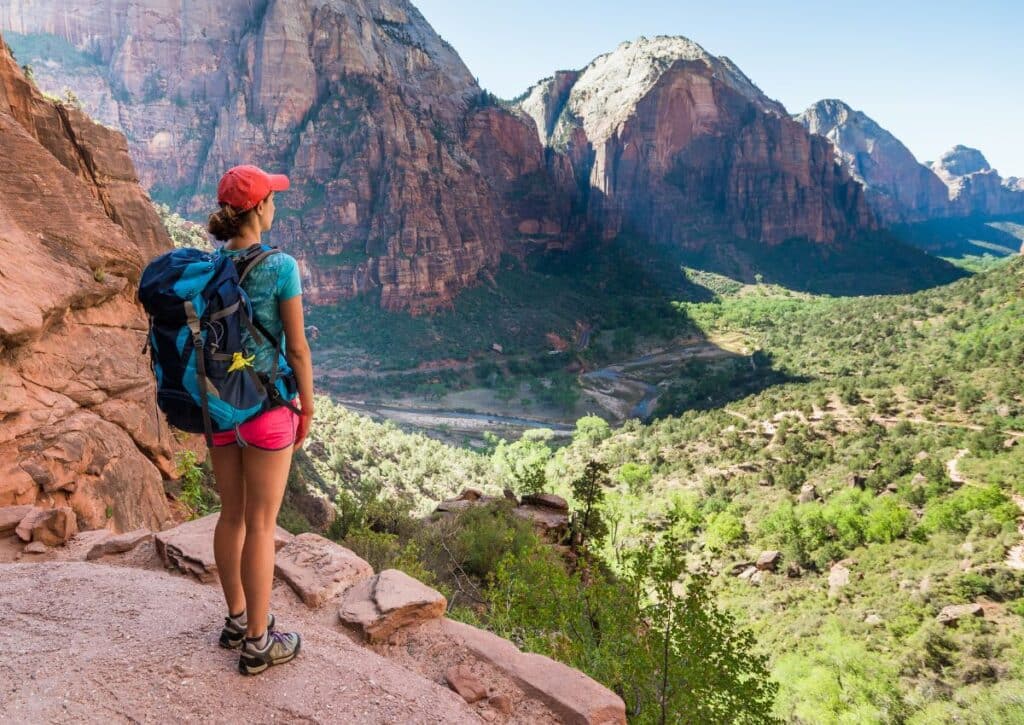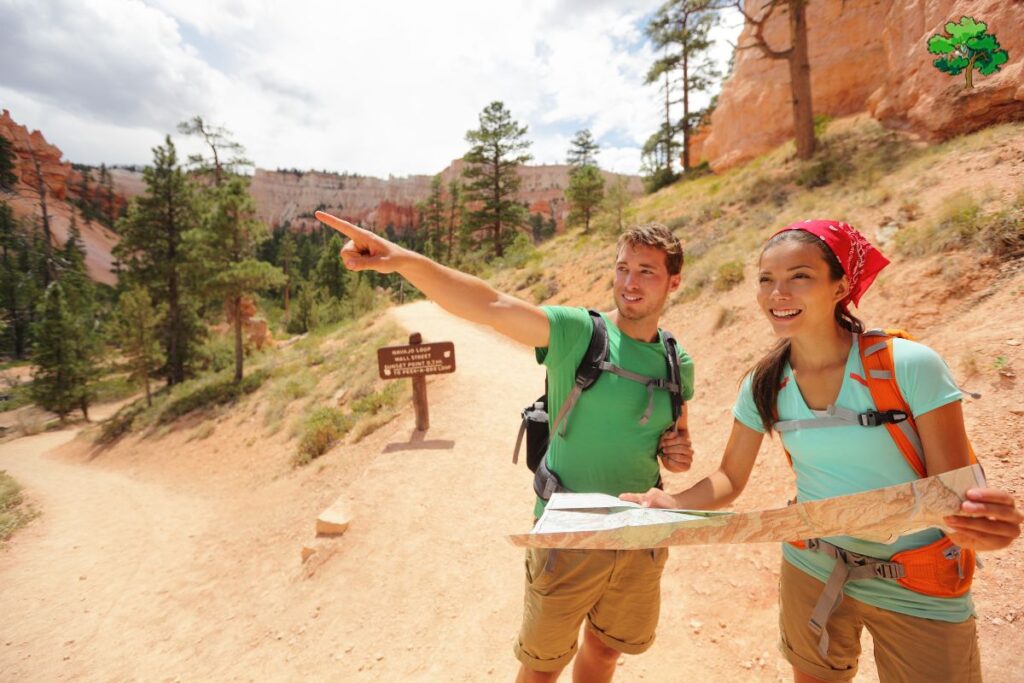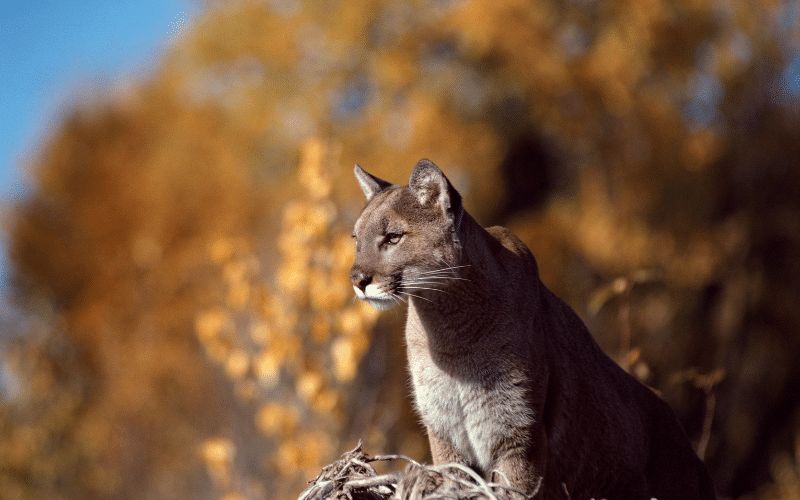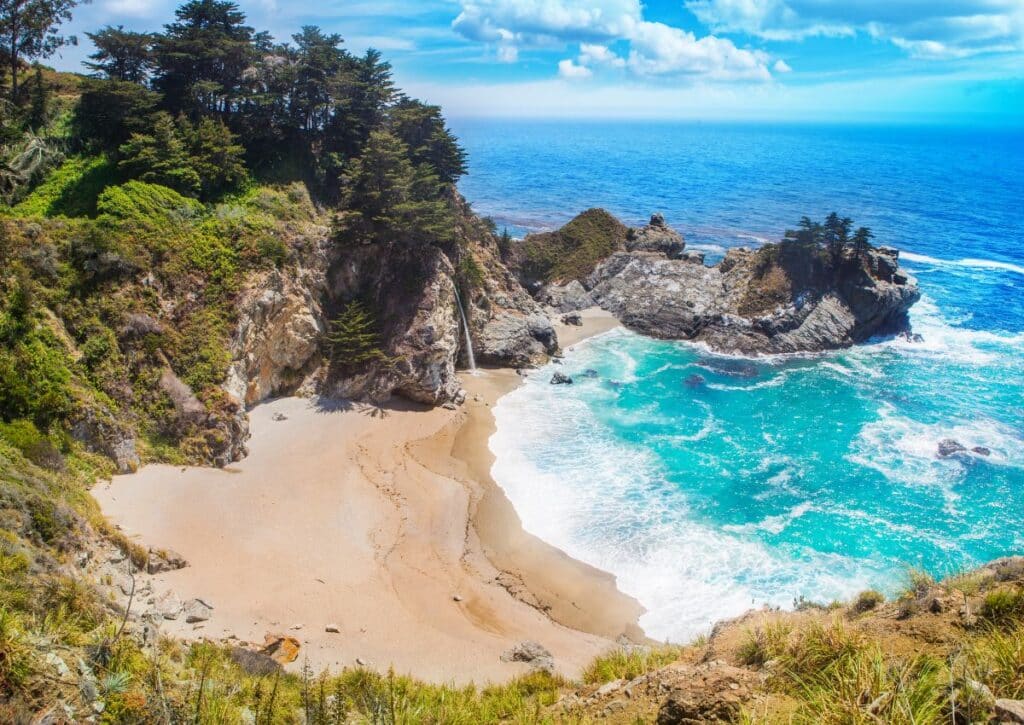Discover wildlife & trails in USA's 63 National Parks. Dive into habitats from Zion to Badlands. Your guide to pristine landscapes & ecosystems.
Dive deep into the habitats of unique wildlife, from the elusive mountain lions of Zion to the bighorn sheep of Badlands.
For outdoor enthusiasts and wildlife lovers alike, we spotlight key trails that promise immersive experiences amidst nature’s raw beauty.
This guide is your compass to the pristine landscapes and vibrant ecosystems that define each park. Let’s explore the wild together.
Which are the 63 National Parks?
| Park | State | Year Established | Highlights of the Park |
|---|---|---|---|
| Dry Tortugas National Park | Florida | 1935 | Historic Fort Jefferson, pristine coral reefs |
| Everglades National Park | Florida | 1947 | Mangrove forests, diverse wildlife |
| Yosemite National Park | California | 1890 | Iconic cliffs, waterfalls, and giant sequoias |
| Big Bend National Park | Texas | 1944 | Vast desert expanses, the Rio Grande, and Chisos Mountains |
| Guadalupe Mountains National Park | Texas | 1972 | World’s most extensive Permian fossil reef |
| Hot Springs National Park | Arkansas | 1921 | Historic bathhouses and natural hot springs |
| Great Sand Dunes National Park and Preserve | Colorado | 1932 | Tallest sand dunes in North America |
| Carlsbad Caverns National Park | New Mexico | 1930 | Extensive limestone caves and underground chambers |
| Rocky Mountain National Park | Colorado | 1915 | High mountain peaks, alpine lakes, and diverse wildlife |
| Wind Cave National Park | South Dakota | 1903 | One of the world’s longest and most complex caves |
| Theodore Roosevelt National Park | North Dakota | 1978 | Badlands terrain, where the 26th president lived as a young man |
| Badlands National Park | South Dakota | 1978 | Dramatic landscapes of layered rock formations, canyons, and spires |
| Grand Teton National Park | Wyoming | 1929 | Majestic Teton Range, alpine terrain, and diverse wildlife |
| Yellowstone National Park | Wyoming (MT & ID) | 1872 | World’s first national park, geysers, and abundant wildlife |
| Glacier National Park | Montana | 1910 | Mountain landscapes, pristine forests, and alpine meadows |
| Lake Clark National Park | Alaska | 1980 | Volcanoes, waterfalls, and diverse habitats |
| Mount Rainier National Park | Washington | 1899 | Iconic stratovolcano surrounded by wildflowers and forests |
| Olympic National Park | Washington | 1938 | Rainforests, alpine highlands, and Pacific coastline |
| North Cascades National Park | Washington | 1968 | Jagged peaks, deep valleys, cascading waterfalls, and over 300 glaciers |
| Redwood National and State Parks | California | 1968 | Tallest trees on Earth, old-growth temperate rainforests |
| Crater Lake National Park | Oregon | 1902 | Deepest lake in the U.S., formed from a collapsed volcano |
| Lassen Volcanic National Park | California | 1916 | Active geothermal features, including fumaroles, boiling springs, and mud pots |
| Kings Canyon National Park | California | 1940 | Rugged mountain landscapes and vast caverns |
| White Sands National Park | New Mexico | 2019 | World’s largest gypsum dunefield |
| Kenai Fjords National Park | Alaska | 1980 | Glaciers, fjords, and abundant marine life |
| Wrangell-St. Elias National Park & Preserve | Alaska | 1980 | Largest national park in the U.S., with vast glaciers and the St. Elias mountain range |
| Gates of the Arctic National Park & Preserve | Alaska | 1980 | One of the last truly wild places, with no roads or trails |
| Denali National Park & Preserve | Alaska | 1917 | Tallest peak in North America, Denali (formerly Mt. McKinley) |
| Katmai National Park & Preserve | Alaska | 1918 | Notable for brown bears and the Valley of Ten Thousand Smokes |
| Channel Islands National Park | California | 1980 | Five rugged islands, with rich biodiversity |
| Sequoia National Park | California | 1890 | Giant sequoia trees, including the General Sherman Tree |
| Death Valley National Park | California & Nevada | 1994 | Hottest, driest, and lowest national park |
| Pinnacles National Park | California | 2013 | Ancient volcanic formations and talus caves |
| Joshua Tree National Park | California | 1994 | Unique Joshua trees and starry night skies |
| Petrified Forest National Park | Arizona | 1962 | One of the world’s largest and most colorful concentrations of petrified wood |
| Saguaro National Park | Arizona | 1994 | Giant saguaro cacti, symbolic of the American West |
| Grand Canyon National Park | Arizona | 1919 | Iconic and vast red-rock canyon carved by the Colorado River |
| Mesa Verde National Park | Colorado | 1906 | Best-preserved Ancestral Puebloan archaeological sites |
| Black Canyon of the Gunnison National Park | Colorado | 1999 | Steep canyon walls and craggy spires |
| Glacier Bay National Park | Alaska | 1980 | Tidewater glaciers and a dynamic coastline |
| Haleakalā National Park | Hawaii | 1916 | Dormant volcano and unique landscapes |
| Arches National Park | Utah | 1971 | Over 2,000 natural stone arches |
| Canyonlands National Park | Utah | 1964 | Vast landscapes of canyons, mesas, and buttes |
| Capitol Reef National Park | Utah | 1971 | Waterpocket Fold, a nearly 100-mile long warp in the Earth’s crust |
| Bryce Canyon National Park | Utah | 1928 | Hoodoos (tall, thin spires of rock) and natural amphitheaters |
| Zion National Park | Utah | 1919 | Red and pink sandstone cliffs and scenic canyons |
| Great Basin National Park | Nevada | 1986 | Lehman Caves and ancient bristlecone pine trees |
| Hawai’i Volcanoes National Park | Hawaii | 1916 | Active volcanoes and unique geological features |
| Kobuk Valley National Park | Alaska | 1980 | Sand dunes, the Kobuk River, and caribou migration |
| Voyageurs National Park | Minnesota | 1975 | Northern lakes, forests, and wildlife |
| Isle Royale National Park | Michigan | 1940 | Wilderness island in Lake Superior |
| Cuyahoga Valley National Park | Ohio | 2000 | Scenic river, waterfalls, and rolling hills |
| Indiana Dunes National Park | Indiana | 2019 | Sand dunes, wetlands, and forests |
| Gateway Arch National Park | Missouri | 2018 | Iconic arch symbolizing westward expansion |
| Mammoth Cave National Park | Kentucky | 1941 | World’s longest known cave system |
| Shenandoah National Park | Virginia | 1935 | Scenic Skyline Drive and a part of the Blue Ridge Mountains |
| Great Smoky Mountains National Park | Tennessee & North Carolina | 1934 | Mist-covered mountains and diverse plant and animal life |
| Acadia National Park | Maine | 1919 | Atlantic coastline, forests, lakes, and Mount Desert Island |
| New River Gorge National Park and Preserve | West Virginia | 2020 | Ancient river, deep canyons, and whitewater rafting |
| Congaree National Park | South Carolina | 2003 | Tallest deciduous forest canopy in the U.S. |
| National Park of American Samoa | American Samoa | 1988 | Tropical rainforests and coral reefs |
| Biscayne National Park | Florida | 1980 | Aquatic park with coral reefs and mangrove forests |
| Virgin Islands National Park | US Virgin Islands | 1956 | Tropical paradise with blue waters, white sand beaches, and coral reefs |
1. Dry Tortugas National Park, Florida
An isolated gem, Dry Tortugas is composed of seven small islands surrounded by crystalline waters, accessible only by boat or seaplane.
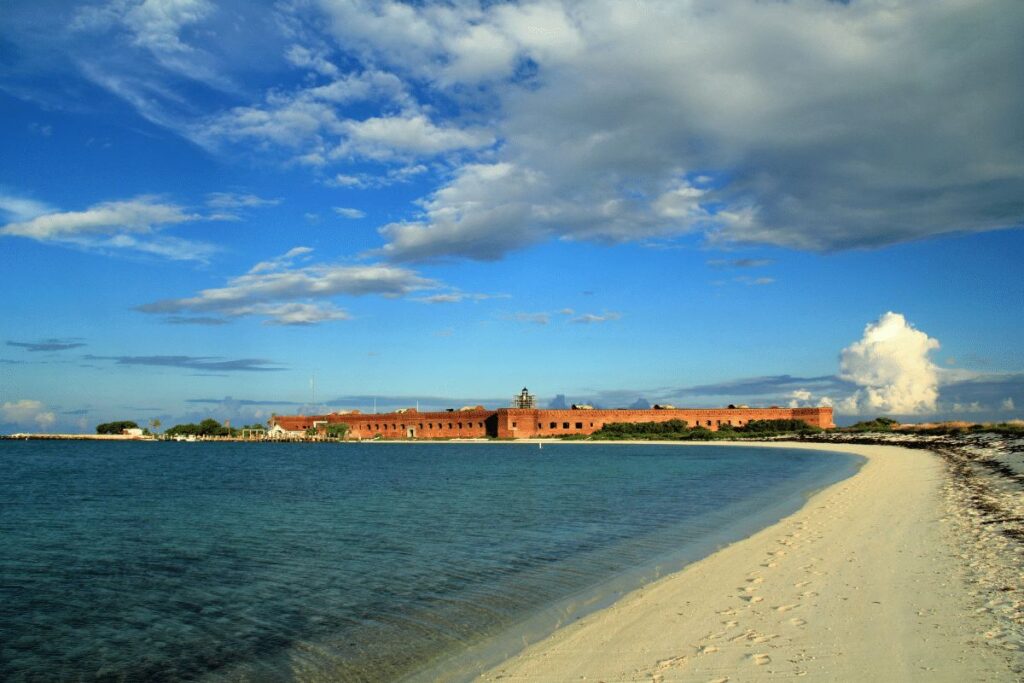
Wildlife: The surrounding waters teem with colorful coral reefs and diverse marine life, making it a snorkeler’s paradise. Terns, frigatebirds, and migratory birds stop at these islands, providing a unique bird-watching experience.
Trails:
- Fort Jefferson Tour: While not a traditional trail, this guided tour delves deep into the massive coastal fortress’s history.
- Moat Wall Walk (0.75 miles): Circumvent Fort Jefferson while enjoying panoramic ocean vistas.
- Bush Key Trail (Seasonal, 1 mile roundtrip): A nesting site for terns, it offers solitude and expansive sea views.
2. Everglades National Park, Florida
An intricate web of wetlands, the Everglades sprawls across Florida’s tip, presenting a mosaic of mangroves, marshes, and freshwater sloughs.
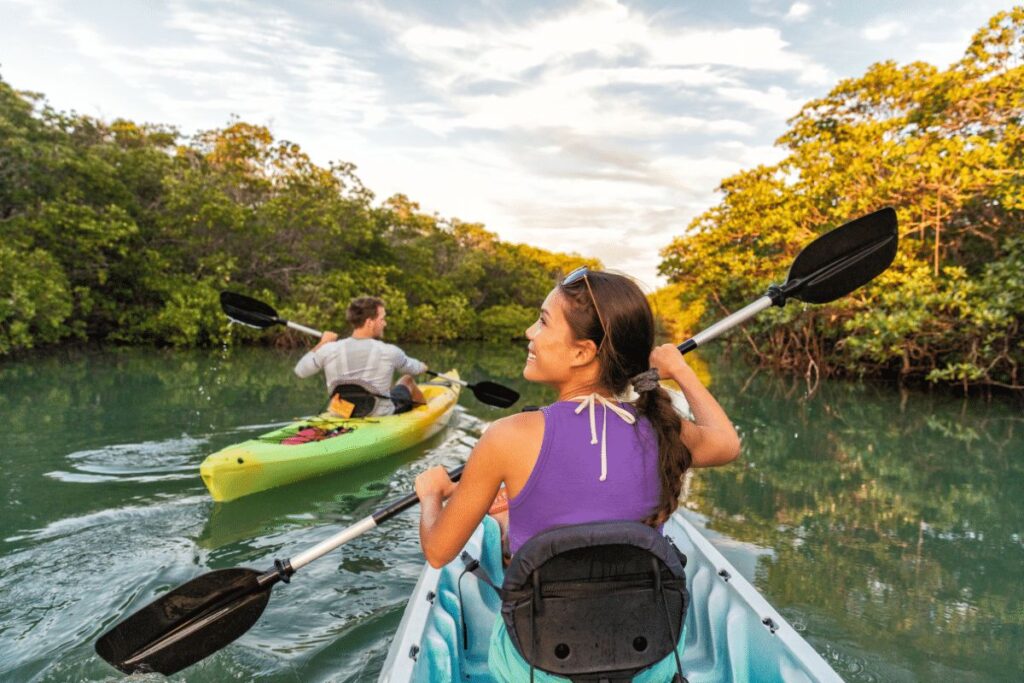
Wildlife: Renowned for its birdlife—roseate spoonbills, wood storks, and ospreys. The waterways house the American alligator, and the elusive Florida panther prowls its backcountry.
Trails:
- Anhinga Trail (0.8 miles): A boardwalk providing close encounters with abundant wildlife, especially alligators.
- Shark Valley Loop (15 miles): Mostly flat, this trail offers bikers and hikers a comprehensive look into the park’s diverse ecosystems.
- Gumbo Limbo Trail (0.4 miles): A shaded path showcasing a variety of plants native to the region.
3. Yosemite National Park, California
Nestled within California’s Sierra Nevada mountains, Yosemite is renowned for its grand waterfalls, giant sequoias, and vast meadows. The iconic granite cliffs of El Capitan and Half Dome are a climber’s paradise, while the valley below tells a tale of glacial forces carving through ancient stone.
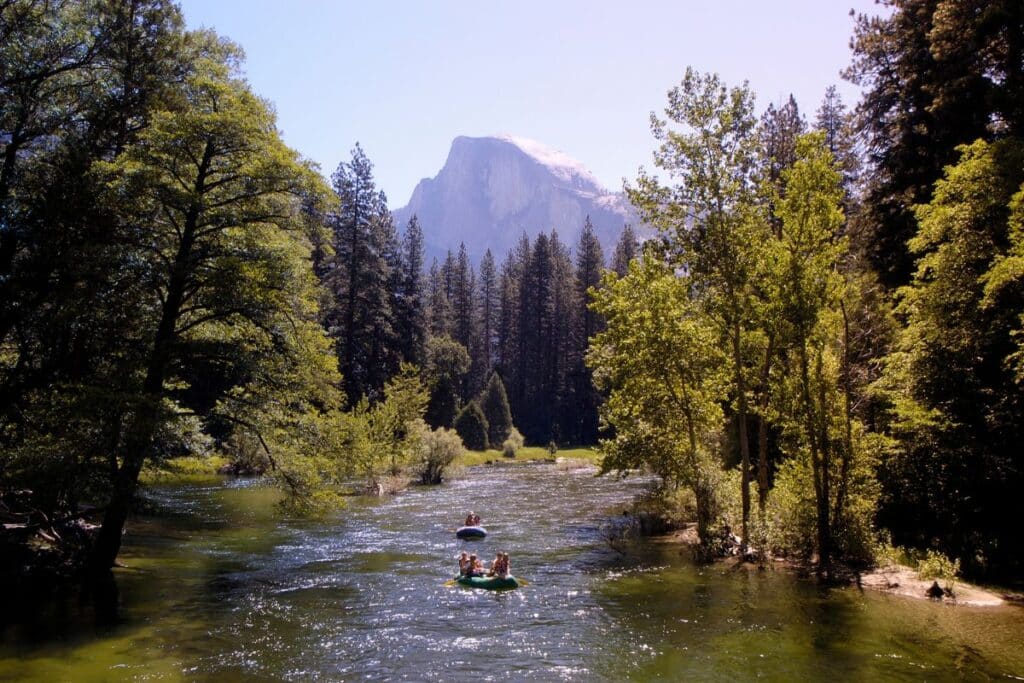
Wildlife: Black bears, mule deer, and over 160 species of birds can be spotted, with the park’s meadows often hosting sightings of its resident wildlife.
Trails:
- Mist Trail (7 miles roundtrip): A popular path leading to the Vernal and Nevada Falls, giving hikers a wet experience during spring and early summer when the falls are at their fullest.
- Mariposa Grove of Giant Sequoias (6 miles roundtrip for the full loop): A walk among ancient giants, this trail takes visitors to over 500 mature giant sequoias including the Grizzly Giant and the California Tunnel Tree.
- Yosemite Falls Trail (7.2 miles roundtrip to the top): A strenuous hike offering close-up views of the tallest waterfall in North America, and panoramic views of the valley from the top.
4. Big Bend National Park, Texas
Straddling the U.S.-Mexico border, Big Bend showcases the vast Chihuahuan Desert, interrupted by the Rio Grande’s winding flow.
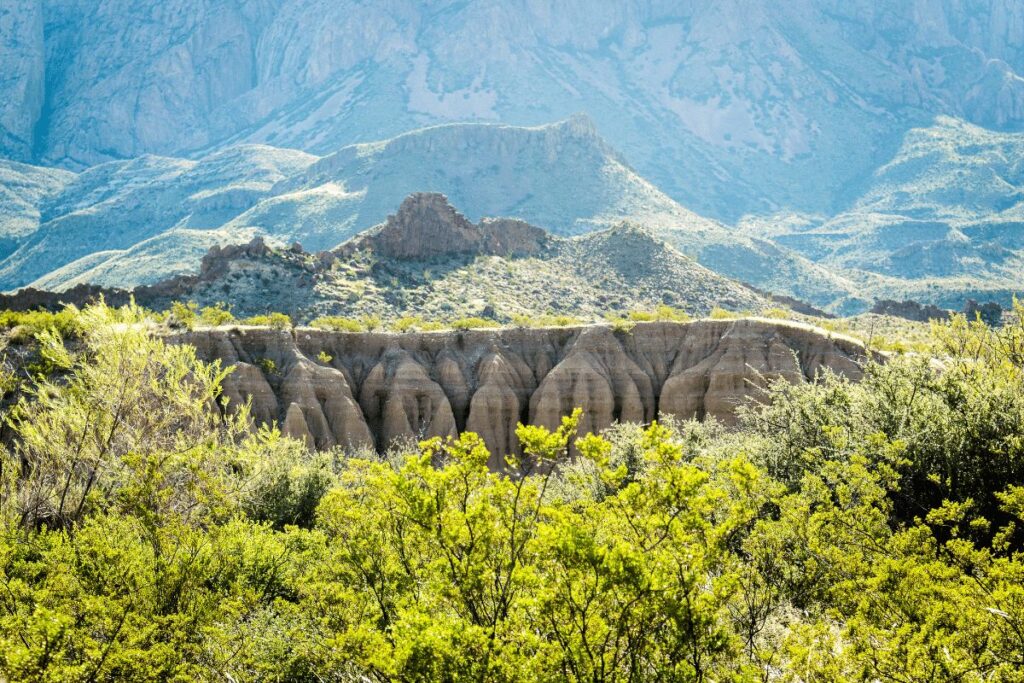
Wildlife: Sightings of roadrunners, black bears, and mountain lions are not uncommon. The Colima warbler, a rare bird species, also calls the park home.
Trails:
- Lost Mine Trail (4.8 miles roundtrip): Offering panoramic views of the Chisos Mountains and canyons.
- Santa Elena Canyon Trail (1.7 miles roundtrip): A trail leading to the towering walls of a river-formed canyon.
- South Rim Trail (12 miles roundtrip): A challenging hike with unmatched vistas of the desert and distant mountains.
5. Guadalupe Mountains National Park, Texas
Rising from the Chihuahuan Desert, the Guadalupe Mountains are a testament to ancient marine life, showcasing one of the finest examples of a Permian-era fossil reef.
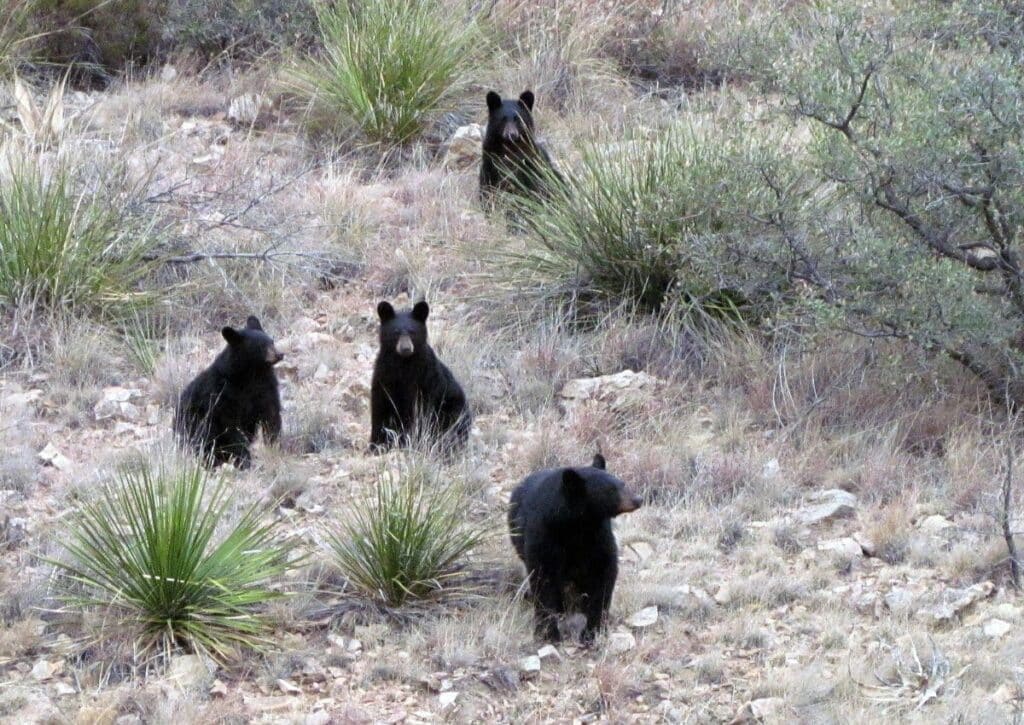
Wildlife: Spot elk grazing in the meadows, while raptors like hawks and eagles soar against the backdrop of the park’s rugged peaks. The caves also harbor a rich population of bats.
Trails:
- Guadalupe Peak Trail (8.4 miles roundtrip): Ascend to Texas’ highest point and revel in the expansive desert views.
- McKittrick Canyon Trail (4.8 miles roundtrip): A path leading to a verdant canyon, especially radiant in the fall.
- Devil’s Hall Trail (3.8 miles roundtrip): Navigate a natural rock stairway to reach a picturesque narrow hallway.
6. Hot Springs National Park, Arkansas
Nestled in the heart of the city of Hot Springs, this unique park blends natural thermal waters, lush forests, and rich history.
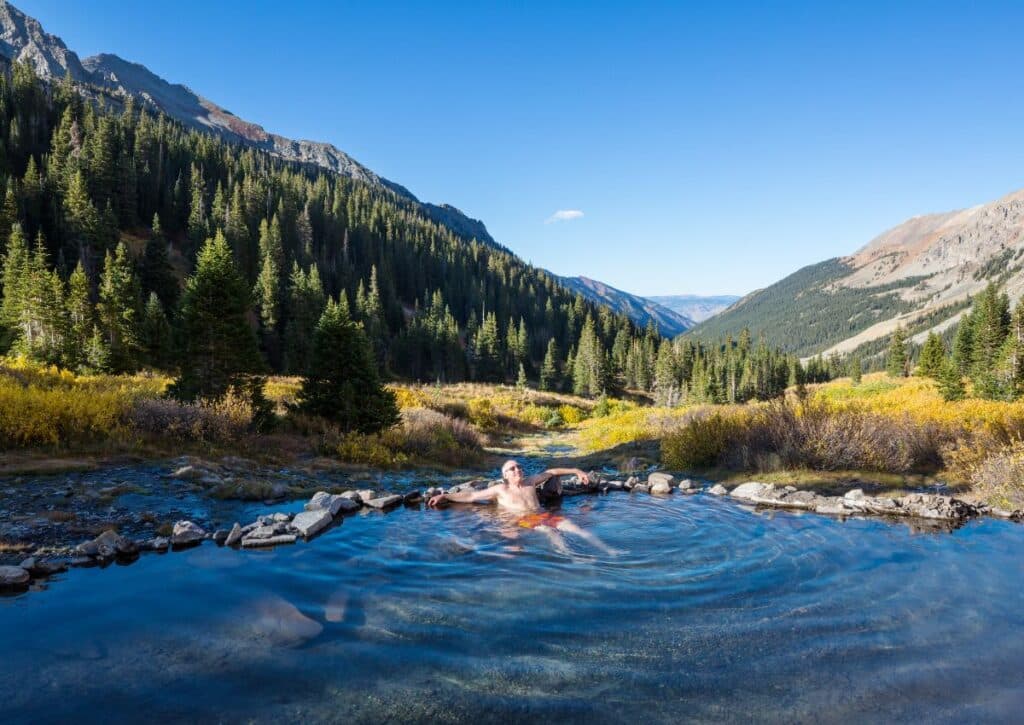
Wildlife: While urban, the park offers a sanctuary for white-tailed deer, armadillos, and a variety of birds.
Trails:
- Hot Springs Mountain Tower Trail (1.7 miles): A trail leading to a tower with panoramic views of the Ouachita Mountains.
- Sunset Trail (10 miles): The park’s longest trail, winding through various terrains and offering multiple vistas.
- Tufa Terrace Trail (0.4 miles): A gentle path showcasing the park’s thermal springs and tufa formations.
7. Great Sand Dunes National Park and Preserve, Colorado
Beneath the shadow of the Sangre de Cristo Mountains, these sand dunes are the tallest in North America, offering a surreal desert landscape.
Wildlife: Amidst the dunes, look for kangaroo rats and the Great Sand Dunes tiger beetle. At night, owls hunt in the shifting sands.
Trails:
- High Dune on First Ridge (~2 miles roundtrip): Climb to achieve unparalleled views of the entire dune field.
- Mosca Pass Trail (7 miles roundtrip): A wooded trail leading to a mountain pass.
- Medano Creek Trail (Variable): Seasonal flow creates a beach-like experience at the base of the dunes.
8. Carlsbad Caverns National Park, New Mexico
Stretching out into the Chihuahuan Desert in New Mexico, Carlsbad Caverns National Park is a treasure trove of underground wonders. Boasting more than 119 known caves, it’s the intricate limestone formations, like stalactites and stalagmites, that truly captivate visitors.
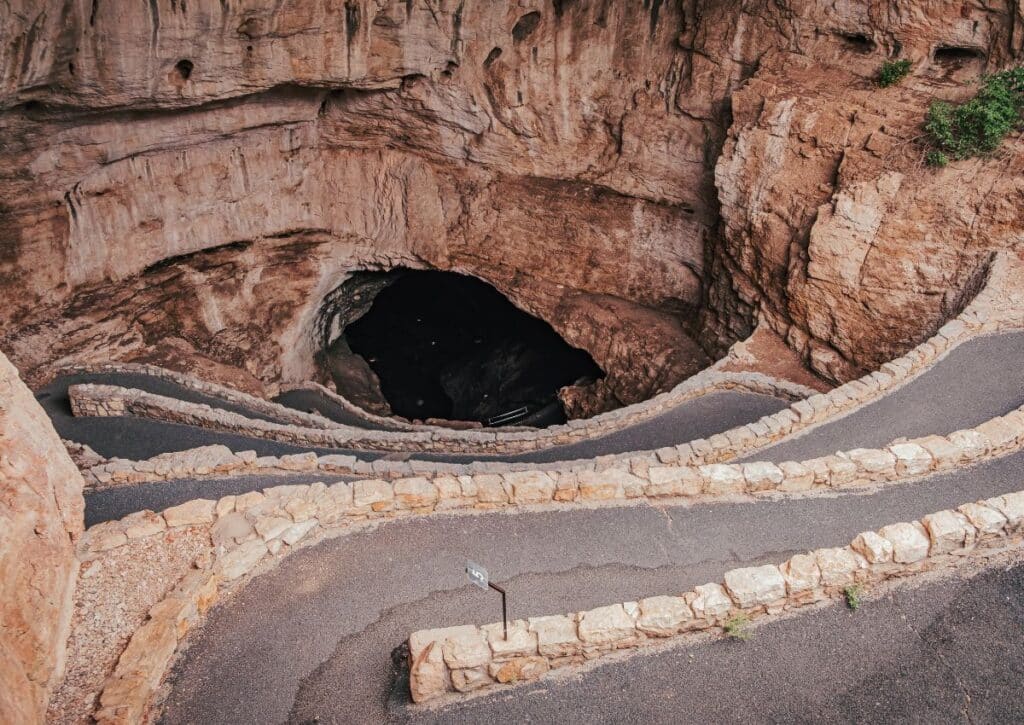
Wildlife: The park is famed for its colony of Brazilian free-tailed bats. Every evening from late April to October, a magical spectacle unfolds as thousands of bats emerge from the cavern’s entrance, swirling like a living tornado against the backdrop of the setting sun.
Trails:
- Big Room Trail (1.25 miles): An accessible trail that winds its way through the park’s largest chamber, showcasing an array of otherworldly formations.
- Natural Entrance Trail (1.25 miles one way): This trail descends steeply into the cavern, tracing a path alongside the bat’s nightly flight path and revealing magnificent cave features.
- Slaughter Canyon Cave Trail (guided tour only): A challenging trail offering a chance to witness some of the park’s most unique mineral formations, including the 89-foot-tall Monarch, one of the world’s tallest columns.
9. Rocky Mountain National Park, Colorado
A realm of majestic peaks and alpine lakes, this park captures the essence of the Colorado Rockies.
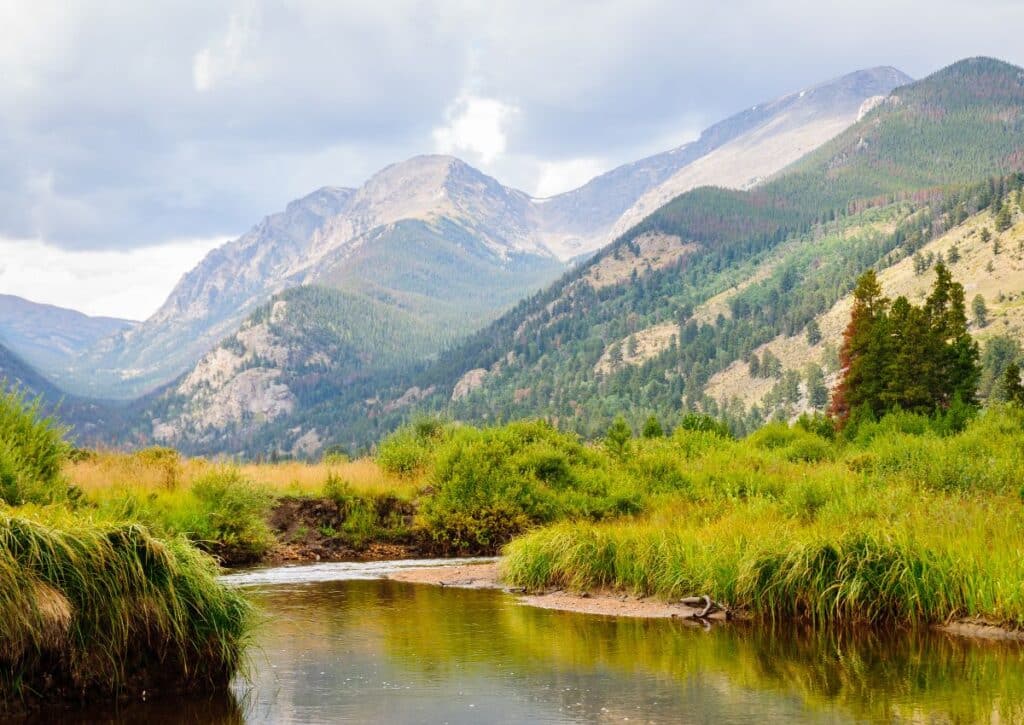
Wildlife: Home to a robust elk population, you might also encounter marmots, bighorn sheep, and the ever-elusive lynx.
Trails:
- Emerald Lake Trail (3.5 miles roundtrip): Pass by a series of stunning lakes with views of Hallett Peak.
- Sky Pond via Glacier Gorge Trail (9.5 miles roundtrip): Traverse past waterfalls and alpine landscapes to reach the serene Sky Pond.
- Deer Mountain Trail (6.2 miles roundtrip): A moderate hike offering panoramic views from the summit.
10. Wind Cave National Park, South Dakota
One of the oldest national parks, Wind Cave is famous for its complex underground maze of passages adorned with boxwork and frostwork formations.
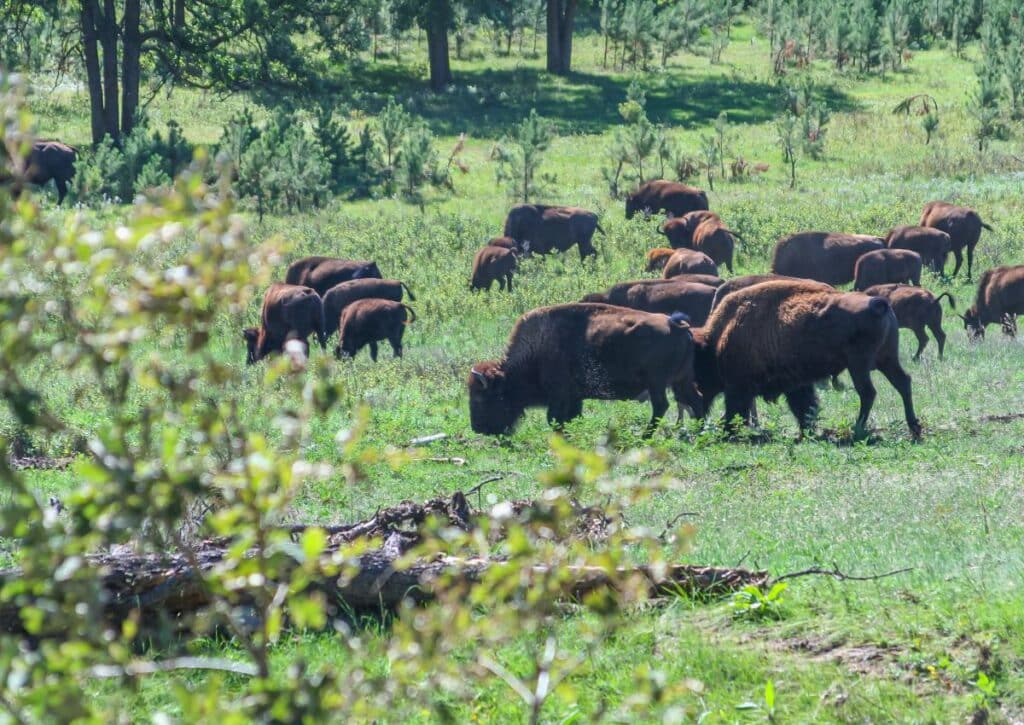
Wildlife: Above ground, prairies are home to bison, pronghorns, and prairie dogs. Black-footed ferrets, once considered extinct, were reintroduced and can be spotted on rare occasions.
Trails:
- Rankin Ridge Nature Trail (1 mile roundtrip): A loop offering a panoramic view of the surrounding prairie and the Black Hills.
- Wind Cave Canyon Trail (1.8 miles roundtrip): A flat path perfect for bird watching, especially during spring and fall migrations.
- Elk Mountain Campground Trail (1.4 miles): A gentle hike through a ponderosa pine forest with chances to spot wildlife.
11. Theodore Roosevelt National Park, North Dakota
Named in honor of the president known for his conservation efforts, the park captures the rugged beauty of the North Dakota badlands.
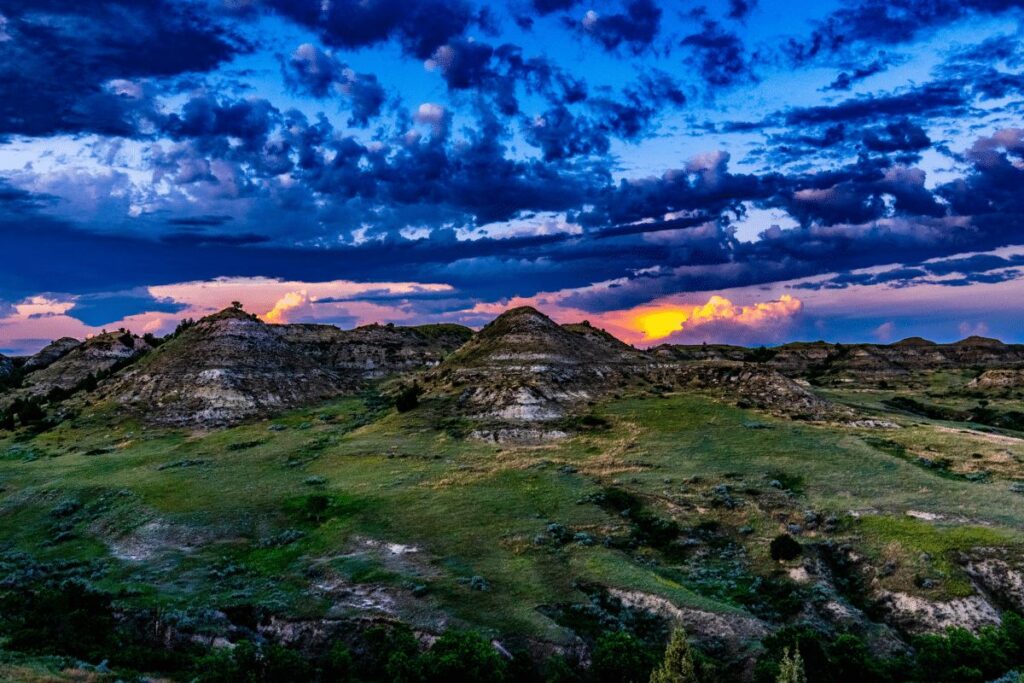
Wildlife: Bison herds are a common sight, alongside wild horses, elk, and coyotes. The park’s skies host golden eagles and prairie falcons.
Trails:
- Wind Canyon Trail (0.4 miles): Overlooking the Little Missouri River, it’s ideal for sunset views.
- Petrified Forest Loop (10.3 miles): Venture into the park’s backcountry to witness large petrified wood deposits.
- Caprock Coulee Trail (4.3 miles): A journey through badlands topography and a mix of grassland and woodland habitats.
12. Badlands National Park, South Dakota
This park stands as a testament to the power of natural forces, featuring layered rock formations, deep canyons, and towering spires.
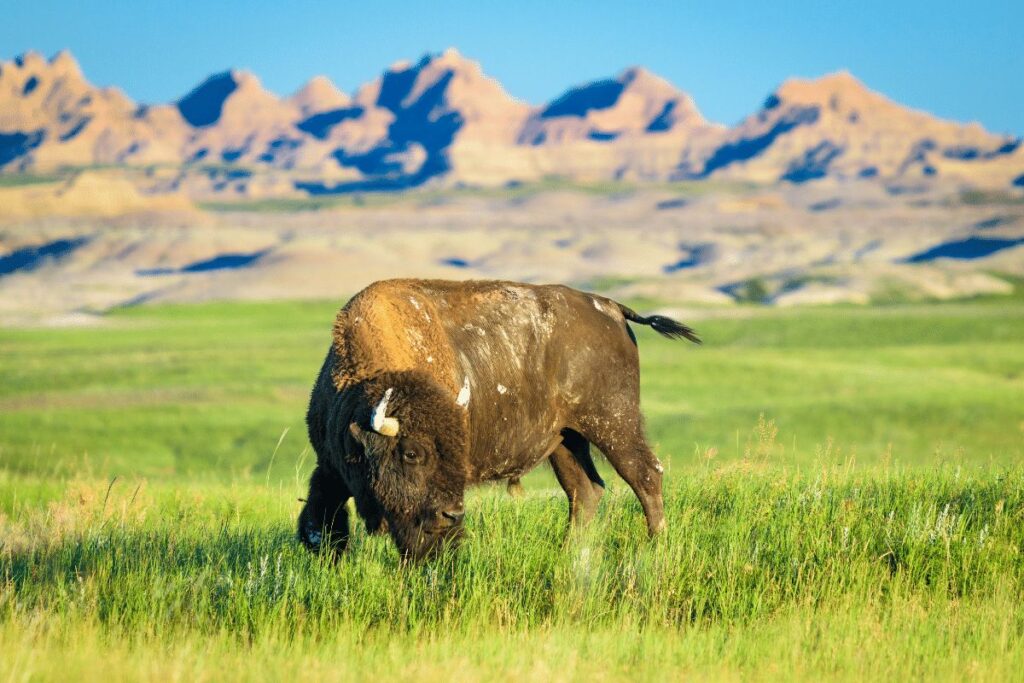
Wildlife: Bison and bighorn sheep dominate the landscape, while the reintroduced black-footed ferret hunts prairie dogs at night.
Trails:
- Notch Trail (1.5 miles roundtrip): A ladder-assisted path offering breathtaking views of the White River Valley.
- Castle Trail (10 miles): Spanning the park’s width, it offers a comprehensive look into the park’s varied landscapes.
- Cliff Shelf Nature Trail (0.5 miles): A boardwalk loop that provides vistas of the badlands and potential bighorn sheep sightings.
13. Grand Teton National Park, Wyoming
The jagged peaks of the Teton Range rise dramatically from the Jackson Hole valley, mirrored in the still waters of the park’s glacial lakes.
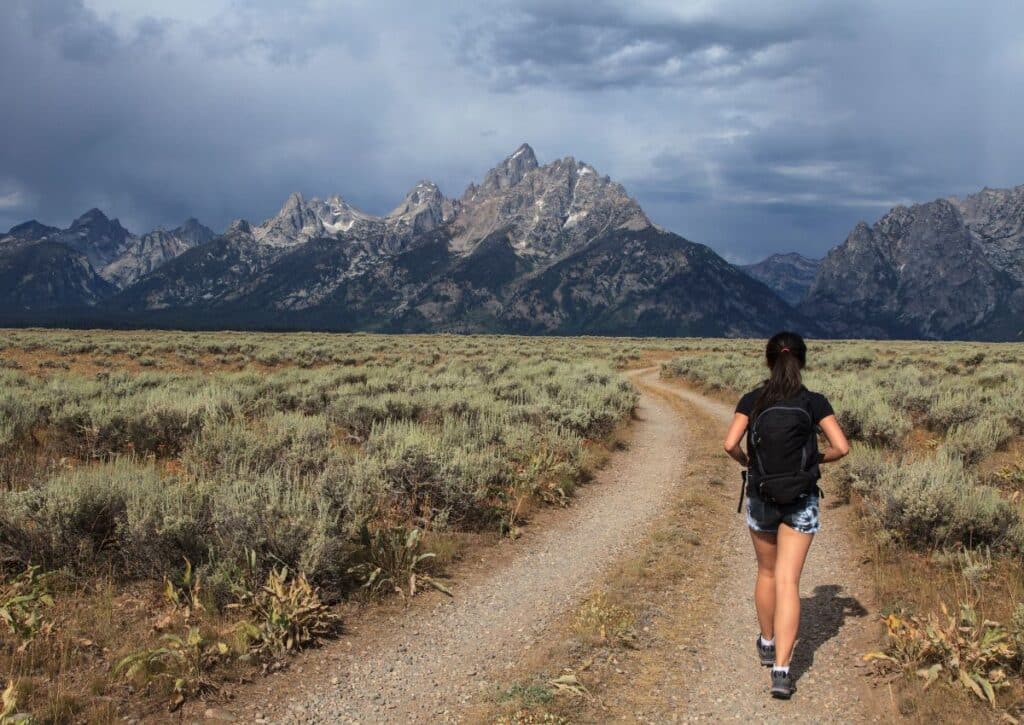
Wildlife: Grizzly bears and black bears wander its vast landscapes. Moose are often seen wading in the Snake River, and golden eagles patrol the skies.
Trails:
- Cascade Canyon Trail (9.7 miles roundtrip): Venture deep into the Teton Range, passing by waterfalls and offering views of the Grand Teton.
- Jenny Lake Loop (7.1 miles): A scenic trail skirting the lake’s edge and offering views of Teewinot Mountain and Cascade Canyon.
- Taggart Lake Trail (3.3 miles roundtrip): A family-friendly hike leading to the serene Taggart Lake, framed by the Tetons.
14. Yellowstone National Park, Wyoming (spreading into Montana and Idaho)
America’s first national park, Yellowstone’s geothermal wonders, sprawling forests, and mighty rivers make it a crown jewel.
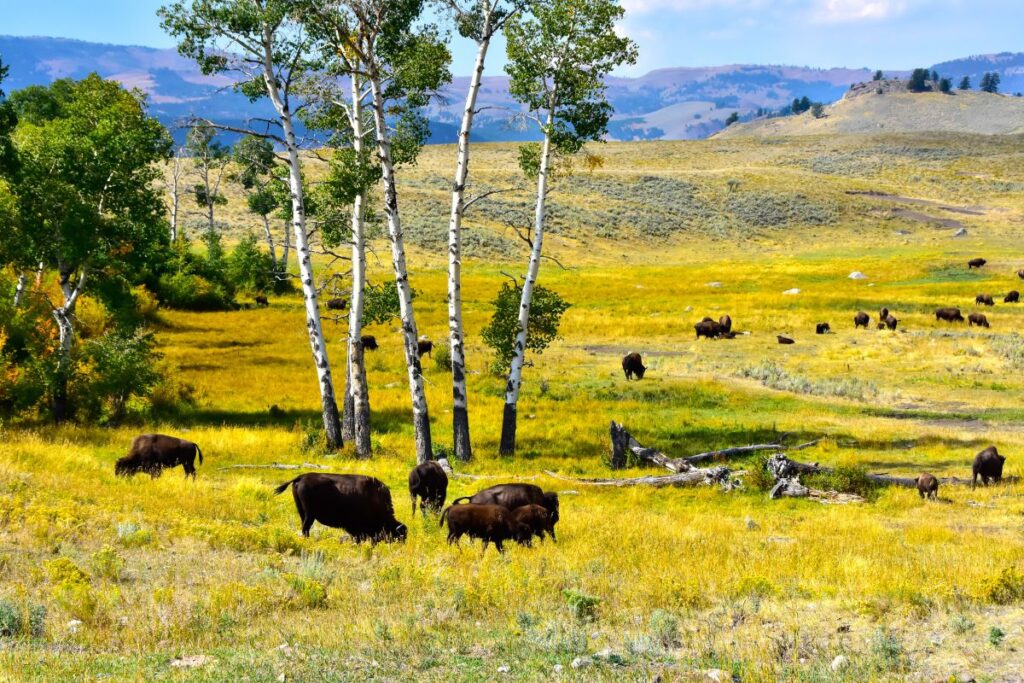
Wildlife: It’s a haven for gray wolves, grizzly bears, and herds of bison and elk. Otters can be seen sliding down the banks of Yellowstone River.
Trails:
- Upper Geyser Basin Trail (5 miles roundtrip): Walk amidst the highest concentration of geysers in the world, including the iconic Old Faithful.
- Grand Canyon of the Yellowstone (Variable lengths): Several trails offer views of the canyon’s waterfalls and colorful walls.
- Mammoth Hot Springs Terraces (Boardwalk trails vary in length): Explore the terraced landscapes formed by hot springs over millennia.
15. Glacier National Park, Montana
Known as the “Crown of the Continent,” Glacier is where pristine forests, alpine meadows, and rugged mountains converge.
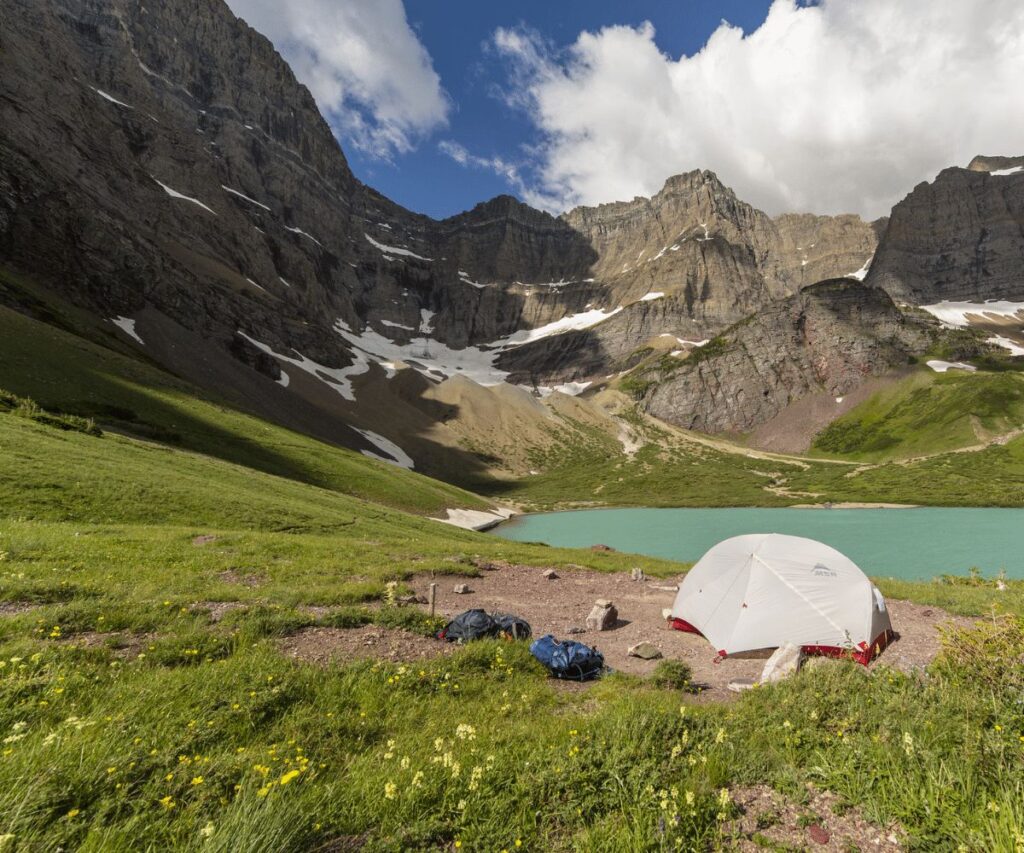
Wildlife: Mountain goats, the park’s iconic symbol, tread on dizzying heights. Grizzly bears, lynxes, and wolverines also find refuge here, amidst the backdrop of receding glaciers.
Trails:
- Grinnell Glacier Trail (10.6 miles roundtrip): Hike to one of the park’s most iconic glaciers, passing by lakes and potential wildlife viewing spots.
- Highline Trail (11.8 miles): Traverse along the Continental Divide, providing breathtaking panoramic views.
- Avalanche Lake Trail (4.5 miles roundtrip): A scenic journey through cedar forests leading to a serene glacial lake.
16. Lake Clark National Park, Alaska
Location: Located in southern Alaska, Lake Clark National Park and Preserve offers a stunning composite of volcanoes, glaciers, wild rivers, and alpine and tundra landscapes.
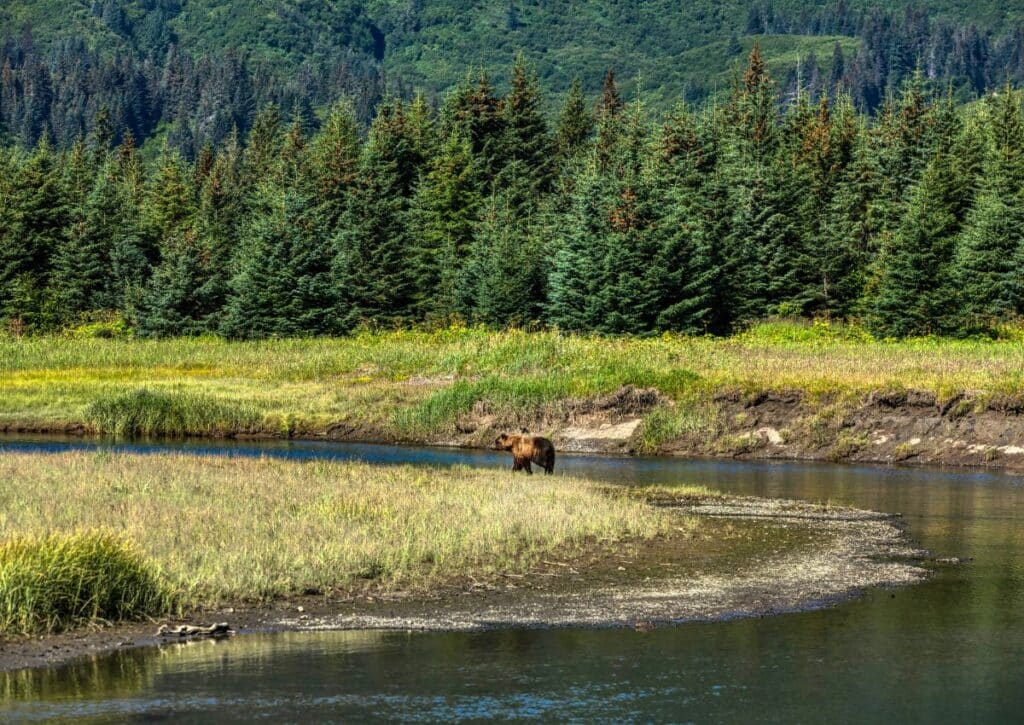
Wildlife: The park is a sanctuary for many animals. Brown bears are perhaps the most iconic inhabitants, often spotted fishing along the salmon-rich rivers or roaming the park’s vast landscapes. In addition to the bears, visitors might also see moose, Dall sheep, wolves, and a myriad of bird species. During the salmon run, the rivers become a hub of activity not just for bears, but also for bald eagles waiting for their share.
Top 3 Trails:
- Tanalian Falls Trail (5 miles round trip) – This trail provides hikers with a moderately challenging trek through forests and meadows, culminating in a viewpoint of the cascading Tanalian Falls.
- Kontrashibuna Lake (2.8 miles round trip) – A shorter trail, but no less beautiful. This path takes you to the pristine Kontrashibuna Lake, offering stunning vistas along the way.
- Beaver Pond Trail (1.3 miles round trip) – A perfect trail for those wanting a short, serene walk. The trail loops around a series of ponds and offers a quiet environment to observe wildlife.
17. Mount Rainier National Park, Washington
Dominating the landscape, Mount Rainier is an active stratovolcano and the most glaciated peak in the contiguous U.S.
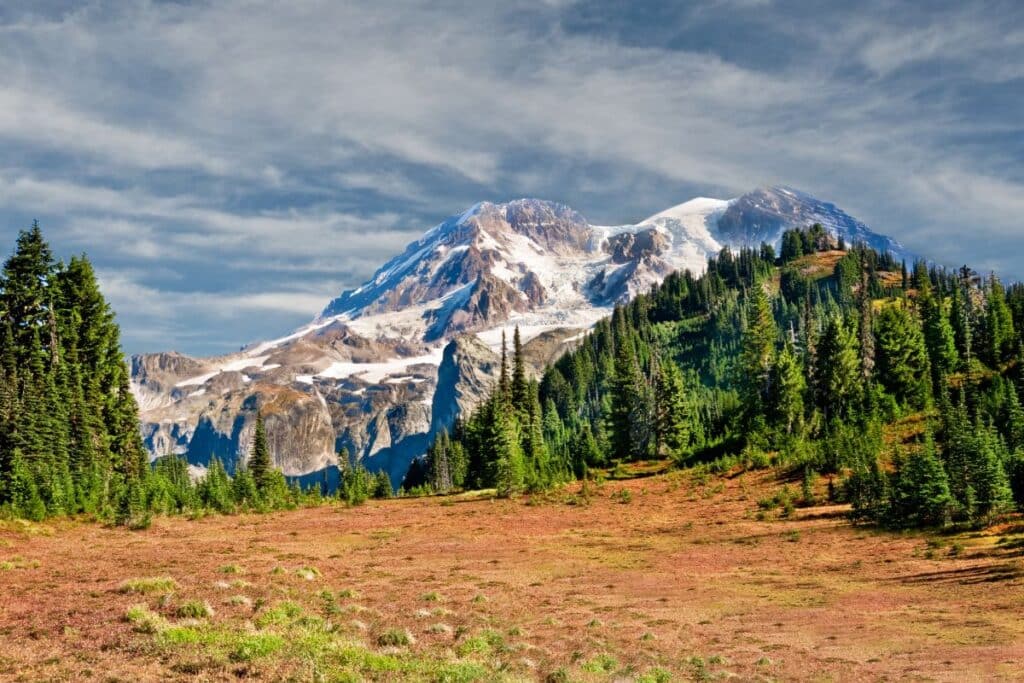
Wildlife: Black-tailed deer graze the meadows, marmots whistle warnings, and black bears search for berries in this alpine wonderland.
Trails:
- Skyline Trail (5.5 miles roundtrip): Encounter wildflower meadows and sweeping vistas of the volcanic landscape.
- Burroughs Mountain Trail (5.4 miles roundtrip): A trek across moon-like landscapes with unmatched views of Mount Rainier.
- Grove of the Patriarchs (1.5 miles roundtrip): Wander among ancient, towering old-growth forests.
18. Olympic National Park, Washington
A land of contrasts, from its rugged coastline and temperate rainforests to the alpine heights of the Olympic Mountains.
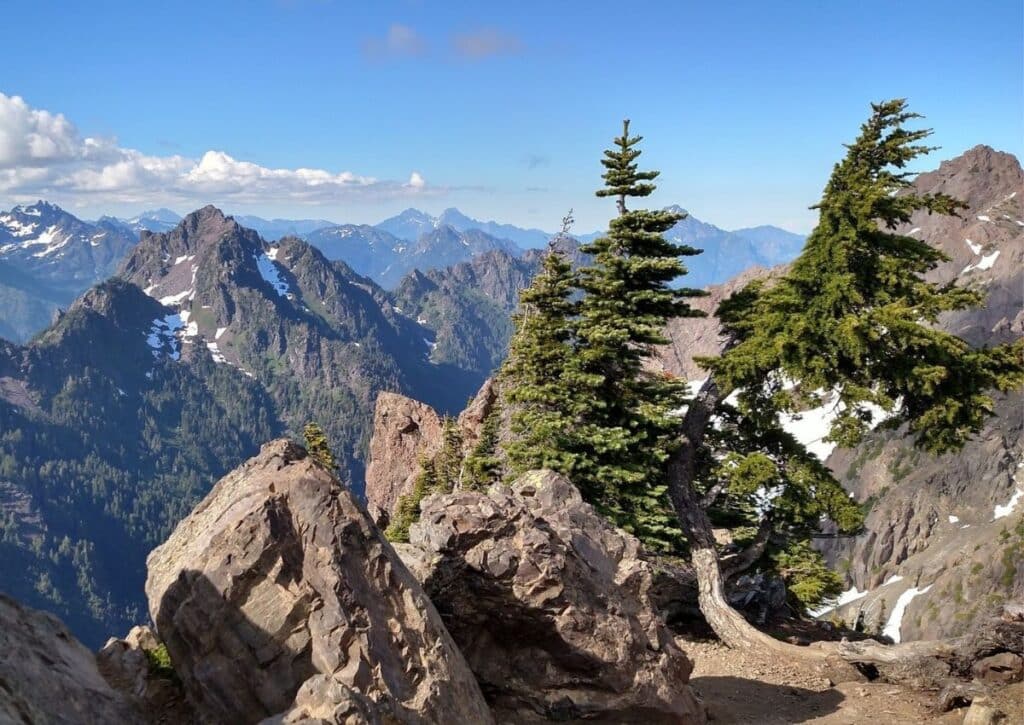
Wildlife: Roosevelt elk are the titans of these forests. The park’s diverse ecosystems also host bobcats, mountain lions, and spotted owls.
Trails:
- Hoh River Trail to Five Mile Island (10.6 miles roundtrip): Journey through temperate rainforest teeming with life.
- Hurricane Ridge Trail (3.2 miles roundtrip): Experience sweeping vistas of the Olympic Mountains and beyond.
- Rialto Beach to Hole-in-the-Wall (4 miles roundtrip): Walk the wild coastline, navigating tide pools and coastal forest.
19. North Cascades National Park, Washington
Often referred to as the “American Alps,” the North Cascades are a rugged, glacier-clad wilderness.
Wildlife: Bald eagles scout the river valleys, while gray wolves and black bears roam the dense forests.
Trails:
- Cascade Pass Trail (7 miles roundtrip): Accessible views of glaciers and a vast mountain panorama.
- Hidden Lake Lookout (9 miles roundtrip): Ascend to a historic fire lookout with sweeping views of the park’s wilderness.
- Diablo Lake Trail (7.6 miles roundtrip): Traverse forested slopes and ridges overlooking the turquoise waters of Diablo Lake.
20. Redwood National and State Parks, California
Home to the tallest trees on Earth, these parks protect a primeval forest that dates back hundreds of millions of years.
Wildlife: Roosevelt elk roam the prairies, while marbled murrelets nest high in the ancient canopy.
Trails:
- Tall Trees Grove Trail (3.9 miles roundtrip): Descend to a grove where some of the world’s tallest trees stand.
- Fern Canyon Trail (1 mile): Wander through a narrow canyon draped in ferns, often used as a filming location.
- James Irvine Trail to Gold Bluffs Beach (11.6 miles roundtrip): Traverse through old-growth forest to emerge on a remote, driftwood-strewn beach.
21. Crater Lake National Park, Oregon
Centered around the deepest lake in the U.S., this park’s blue waters and surrounding cliffs offer a breathtaking spectacle.
Wildlife: Black bears, pikas, and Clark’s nutcrackers are just a few of the species that inhabit this volcanic landscape.
Trails:
- Garfield Peak Trail (3.4 miles roundtrip): Hike for a panoramic view of the lake and Phantom Ship Island.
- Cleetwood Cove Trail (2.2 miles roundtrip): The only access to the lake’s shore, it’s a steep descent with rewarding views.
- Watchman Peak Trail (1.6 miles roundtrip): Ascend to an old fire lookout with vistas of Wizard Island.
22. Lassen Volcanic National Park, California
A geothermal wonderland, this park is home to steaming fumaroles, meadows freckled with wildflowers, and clear mountain lakes.
Wildlife: Red foxes and mule deer can be spotted in the park, while the skies might feature the vibrant western tanager.
Trails:
- Bumpass Hell Trail (3 miles roundtrip): Walk to the park’s largest hydrothermal area, filled with boiling springs and mud pots.
- Lassen Peak Trail (5 miles roundtrip): Summit the park’s iconic volcano, offering sweeping vistas at the top.
- Kings Creek Falls Trail (2.7 miles roundtrip): A scenic trail leading to a cascading waterfall.
23. Kings Canyon National Park, California
Location: Situated in the southern Sierra Nevada mountain range of California, Kings Canyon National Park neighbors Sequoia National Park.
Wildlife: The park is home to a diverse range of animals, including the black bear, mule deer, and mountain lion. Bird enthusiasts can spot mountain bluebirds, Clark’s nutcrackers, and the rare peregrine falcon among the park’s avian residents.
Top 3 Trails:
- Mist Falls Trail (8 miles round trip): This popular trail follows the South Fork of the Kings River, leading hikers to one of the park’s largest waterfalls.
- Rae Lakes Loop (41.4 miles loop): A multi-day trek, this trail offers a comprehensive tour of the park’s varied landscapes, from deep canyons to alpine lakes and high mountain passes.
- Zumwalt Meadow Loop Trail (1.5 miles loop): A shorter trail, perfect for families, this route provides stunning views of the Grand Sentinel, North Dome, and the Kings River as it winds through the meadow.
Kings Canyon, with its dramatic landscapes ranging from cavernous depths to towering peaks, offers visitors a chance to experience the wild beauty of the Sierra Nevada.
24. White Sands National Park, New Mexico
Location: Nestled in southern New Mexico, White Sands National Park is a unique expanse of gleaming gypsum dunes that stretch over 275 square miles.
Wildlife: The dunes are not just a stunning sight but are also home to a plethora of adapted creatures. The elusive bleached earless lizard, which camouflages perfectly against the white sand, calls this place home. Observant visitors might also spot the Apache pocket mouse scurrying about. Birds grace the skies and rest on the dunes; kestrels and red-tailed hawks are common sights, circling above in search of prey.
Trails:
- Dune Life Nature Trail – A 1-mile loop that provides insights into the creatures that thrive in this seemingly inhospitable environment.
- Playa Trail – A short 0.5-mile round-trip, leading you to a dried-up lake bed, giving a glimpse into the park’s geological history.
- Alkali Flat Trail – The longest at 5 miles round-trip, it’s not flat as the name suggests. Instead, it offers a challenging trek through dune fields with breathtaking views.
25. Kenai Fjords National Park, Alaska
Defined by glaciers, fjords, and alpine landscapes, this park offers a glimpse of Alaska’s coastal ecosystems.
Wildlife: Orca and humpback whales grace the fjords, while sea otters float amidst icebergs. Puffins and bald eagles rule the skies.
Trails:
- Exit Glacier Trail (1.9 miles roundtrip): A trail leading to a face of the park’s most accessible glacier.
- Harding Icefield Trail (8.2 miles roundtrip): A challenging ascent that rewards with a view of the expansive icefield.
- Caines Head Coastal Trail (8.6 miles one-way): Trace Resurrection Bay’s shoreline with chances to spot marine life.
26. Wrangell-St. Elias National Park & Preserve, Alaska
The largest national park in the U.S., it showcases diverse terrains from mountains to glaciers to wetlands.
Wildlife: Dall sheep navigate steep terrains, while caribou migrate across vast landscapes. Grizzly bears and wolves are apex predators here.
Trails:
- Root Glacier Trail (4 miles roundtrip): Walk beside the iconic Kennicott Glacier, with options to step onto the ice.
- Bonanza Mine Trail (9 miles roundtrip): Climb above the treeline for views of the Kennicott Valley and its historic copper mines.
- Erie Mine Trail (7 miles roundtrip): Explore the historical mining district, with remnants of past operations and panoramic views.
27. Gates of the Arctic National Park & Preserve, Alaska
One of the last truly wild places, this park is defined by its pristine landscapes and absence of roads.
Wildlife: Muskoxen, caribou, and Arctic foxes thrive in this challenging environment. Gyrfalcons and golden eagles patrol the skies.
Trails:
- There are no established trails. Adventurous souls navigate vast tundras, river valleys, and mountain passes, crafting their own paths.
28. Denali National Park & Preserve, Alaska
Centered around North America’s highest peak, Denali, this park offers diverse landscapes from tundras to alpine ranges.
Wildlife: Large mammals like grizzly bears, wolves, and moose roam freely. Golden eagles and ptarmigans are a few of the bird species found here.
Trails:
- Horseshoe Lake Trail (3.2 miles roundtrip): A serene trail leading to a beautiful lake with beaver activity.
- Savage Alpine Trail (4 miles one-way): Navigate from the Savage River through alpine landscapes with views of Denali on clear days.
- Eielson Visitor Center Trails (Variable lengths): A network of trails offering panoramic views and potential wildlife sightings.
29. Katmai National Park & Preserve, Alaska
Famous for its brown bears and the Valley of Ten Thousand Smokes, Katmai offers a raw Alaskan experience.
Wildlife: Brown bears fishing for salmon are a hallmark. Wolves, foxes, and lynxes also inhabit the park, while a variety of birds nest on its lakes and shores.
Trails:
- Brooks Falls Trail (1.2 miles roundtrip): Watch bears in their natural habitat, especially during the salmon run.
- Valley of Ten Thousand Smokes Tour (23 miles by bus): Explore the remnants of the 1912 Novarupta eruption, with guided hikes available.
- Three Lakes Loop (5 miles roundtrip): Discover the park’s diverse landscapes, from forested areas to open tundras.
30. Channel Islands National Park, California
Comprising five rugged islands, this park is often called the “Galápagos of North America.”
Wildlife: The islands are a haven for rare species, including the island fox and the spotted skunk. Sea lions and seals bask on its shores, while diverse birdlife, including the brown pelican, nests here.
Trails:
- Cavern Point Loop (2 miles roundtrip): Offering coastal views from Santa Cruz Island, with potential dolphin sightings.
- Anacapa Island Light Station Trail (1.5 miles roundtrip): Lead to the historic lighthouse, offering panoramic ocean views.
- Torrey Pines Trail (2 miles roundtrip): Located on Santa Rosa Island, showcasing unique pine forests and expansive ocean vistas.
31. Sequoia National Park, California
Home to immense mountains, rugged foothills, deep canyons, and the world’s largest trees.
Wildlife: Black bears and mule deer roam, while mountain lions patrol shadowed forests. Look up to spot the calliope hummingbird and the mountain chickadee.
Trails:
- General Sherman Tree Trail (1 mile roundtrip): Walk to the world’s largest tree, based on volume.
- Moro Rock Trail (0.5 miles roundtrip): A steep climb offering panoramic views of the Great Western Divide.
- Zumwalt Meadow Loop (1.5 miles roundtrip): Enjoy the serene meadow and rugged granite cliffs in Kings Canyon.
32. Death Valley National Park, California & Nevada
The hottest, driest, and lowest national park, it’s a land of extremes.
Wildlife: Despite its harsh environment, bighorn sheep, roadrunners, and sidewinder rattlesnakes have adapted to its challenges.
Trails:
- Badwater Salt Flat (1.5 miles roundtrip): Walk on the lowest point in North America.
- Golden Canyon to Red Cathedral (3 miles roundtrip): A popular hike through colorful canyons.
- Dante’s View (1 mile roundtrip): Offers breathtaking panoramas of the valley below.
33. Pinnacles National Park, California
Born from ancient volcanic eruptions, this park is a haven for rock climbers and bird enthusiasts.
Wildlife: The California condor can be seen soaring above, while bats claim the park’s many caves. Bobcats and coyotes are among its predators.
Trails:
- Bear Gulch Cave Trail (1.5 miles roundtrip): Explore talus caves and reservoir views.
- High Peaks Loop (6.7 miles roundtrip): Traverse through the heart of the park, with stunning rock formations.
- Condor Gulch Trail (2 miles roundtrip): A great spot for birdwatching, offering views of the park’s peaks.
34. Joshua Tree National Park, California
Characterized by its stark desert landscapes and iconic Joshua trees, the park offers a unique blend of the Colorado and Mojave Deserts.
Wildlife: Roadrunners, bighorn sheep, and black-tailed jackrabbits are common sightings. Night reveals the desert hedgehog cactus and the antics of nocturnal animals.
Trails:
- Hidden Valley Trail (1 mile roundtrip): Discover a rock-enclosed valley, rumored to be a cattle rustler hideout.
- Skull Rock Nature Trail (1.7 miles roundtrip): A loop exploring the park’s iconic rock formations and native plants.
- Arch Rock Nature Trail (0.5 miles roundtrip): Walk to a naturally formed arch, showcasing the park’s unique geology.
35. Petrified Forest National Park, Arizona
Known for its vast landscapes filled with colorful badlands and one of the world’s largest concentrations of petrified wood.
Wildlife: Though seeming barren, it supports life like pronghorns, bobcats, and the vibrant collared lizard.
Trails:
- Blue Mesa Loop (1 mile roundtrip): A journey through vibrant badlands painted in blues and purples.
- Crystal Forest Trail (0.75 miles roundtrip): Meander amidst some of the park’s most exquisite petrified logs.
- Giant Logs Loop (0.4 miles roundtrip): Witness some of the park’s largest and most famous logs.
36. Saguaro National Park, Arizona
A symbol of the American West, this park is dedicated to the nation’s largest cacti, the giant saguaro.
Wildlife: Gila woodpeckers, desert tortoises, and javelinas embody the spirit of this arid region.
Trails:
- Hugh Norris Trail (10 miles roundtrip): Hike to Wasson Peak, the park’s highest point, offering panoramic desert views.
- Cactus Forest Loop Drive (8 miles): A scenic drive (with occasional pull-offs for short walks) showcasing the park’s flora and fauna.
- Desert Ecology Trail (0.5 miles roundtrip): A gentle trail providing insights into the desert ecosystem.
37. Grand Canyon National Park, Arizona
The iconic canyon carved by the Colorado River is a testament to millions of years of geological history.
Wildlife: From elusive mountain lions to California condors, the park is a haven for diverse species.
Trails:
- Bright Angel Trail (Variable distances): A journey into the heart of the canyon with rest houses along the way.
- Rim Trail (13 miles, can be accessed in segments): A mostly flat walk offering various viewpoints of the canyon.
- South Kaibab Trail (Variable distances): A steeper descent into the canyon with iconic vistas like Ooh Aah Point.
38. Mesa Verde National Park, Colorado
Preserving the rich history of the Ancestral Puebloan people, it’s renowned for its well-preserved cliff dwellings.
Wildlife: Mule deer graze on mesa tops, while turkey vultures soar above. Look out for the vibrant mountain bluebird.
Trails:
- Petroglyph Point Trail (2.4 miles roundtrip): Discover ancient rock carvings, a window into the past.
- Cliff Palace Loop (0.9 miles roundtrip): Tour one of the most iconic cliff dwellings in the park.
- Far View Sites Complex (0.75 miles roundtrip): Explore five archaeological sites on a mesa top.
39. Black Canyon of the Gunnison National Park, Colorado
Featuring some of the steepest cliffs and oldest rocks in North America, the park offers a dramatic landscape.
Wildlife: Peregrine falcons nest on cliff faces, while bighorn sheep navigate the rocky terrain.
Trails:
- Painted Wall View (0.3 miles roundtrip): Gaze at the canyon’s highest cliff, adorned with intricate rock patterns.
- Warner Point Nature Trail (1.5 miles roundtrip): A trek leading to expansive vistas of the Black Canyon and beyond.
- Oak Flat Loop Trail (2 miles roundtrip): A moderate hike offering varied perspectives of the canyon.
40. Glacier Bay National Park, Alaska
Located in the southeastern corner of Alaska, Glacier Bay National Park and Preserve is a vast area of snow-capped mountains, deep fjords, and tidewater glaciers. The dynamic landscape is a testament to the ebb and flow of glaciers over millennia, with massive ice formations calving into the bay in a spectacular display of nature’s power.
Wildlife: The park is a haven for marine life, including humpback whales, orcas, and sea otters. On land, brown and black bears roam the shores, while bald eagles soar overhead, scanning the waters for their next meal.
Trails:
- Forest Loop Trail (1 mile): A serene walk through the rainforest near the Glacier Bay Lodge, offering glimpses of local flora and fauna.
- Bartlett River Trail (4 miles roundtrip): This trail meanders through the forest, leading to the mouth of the Bartlett River, where birdwatchers can spot myriad species.
- Mount Fairweather Trail (variable lengths): Although not for the faint of heart, this challenging route offers experienced hikers and climbers panoramic views of the park’s expansive glaciers and the vastness of the Alaskan wilderness.
41. Haleakalā National Park, Hawaii
Perched on the Hawaiian island of Maui, Haleakalā National Park is named after its most dominant feature: the Haleakalā Volcano, whose name translates to “House of the Sun”. The park is a mosaic of diverse landscapes, from the stark volcanic landscapes of its summit to the lush tropical rainforests of its coastal areas.
Wildlife: Endemic Hawaiian species like the nēnē (Hawaiian goose), and the Hawaiian petrel can be found within the park’s boundaries. Colorful honeycreepers and the unique silversword plant, which blooms only once in its lifetime, are among the park’s other treasures.
Trails:
- Sliding Sands Trail (11 miles roundtrip): Leading into the alien-like cinder desert of the volcano’s crater, this trail offers a surreal hiking experience with vibrant mineral colors and vast volcanic landscapes.
- Halemau’u Trail (8.6 miles roundtrip): This path provides breathtaking views of the crater and opportunities to spot native birds and plants.
- Pīpīwai Trail (4 miles roundtrip): Situated in the park’s Kīpahulu District, this trail takes visitors through lush bamboo forests, past cascading waterfalls, and to the majestic Waimoku Falls.
42. Arches National Park, Utah
This red-rock wonderland has over 2,000 natural stone arches, creating a mesmerizing play of light and shadow.
Wildlife: The desert environment houses the cunning kit fox, bighorn sheep, and a range of desert-adapted birds.
Trails:
- Delicate Arch Trail (3 miles roundtrip): Walk to one of the most iconic arches in the world.
- Windows Loop Trail (1 mile roundtrip): Explore a concentration of massive arches.
- Landscape Arch Trail (1.6 miles roundtrip): Witness one of the longest natural arches in the world.
43. Canyonlands National Park, Utah
A vast landscape of canyons, mesas, and deep river gorges. It’s a rugged wilderness echoing stories of geological wonder.
Wildlife: Ravens soar above, while below, mule deer and desert bighorn sheep navigate the canyon maze.
Trails:
- Mesa Arch Trail (0.5 miles roundtrip): A short hike to an iconic sunrise spot overlooking the vast canyons.
- Grand View Point Trail (2 miles roundtrip): Experience panoramic views of the sculpted landscape.
- Upheaval Dome Overlook Trail (1.7 miles roundtrip): Ponder the mystery of this unique geological structure.
44. Capitol Reef National Park, Utah
Known for the Waterpocket Fold, a nearly 100-mile long warp in the Earth’s crust, it’s a hidden treasure filled with cliffs, canyons, domes, and bridges.
Wildlife: Among the park’s red rock, watch for golden eagles, ringtail cats, and black-tailed jackrabbits.
Trails:
- Hickman Bridge Trail (2 miles roundtrip): Walk to a stunning natural bridge.
- Cohab Canyon Trail (3.4 miles roundtrip): Discover slot canyons and vantage points of Fruita Historic District.
- Golden Throne Trail (4 miles roundtrip): Hike to close-up views of the park’s iconic golden domes.
45. Bryce Canyon National Park, Utah
A geological amphitheater filled with hoodoos — tall, red rock spires formed by millennia of erosion.
Wildlife: The park is home to mule deer, pronghorns, and the endangered Utah prairie dog.
Trails:
- Navajo Loop Trail (1.3 miles roundtrip): Delve into the heart of the canyon, passing iconic formations like Thor’s Hammer.
- Sunrise to Sunset Point Trail (1 mile roundtrip): A flat path offering panoramic views of the amphitheater.
- Rim Trail (Variable distances): Walk along the plateau’s edge, soaking in vistas of the hoodoo-filled canyon.
46. Zion National Park, Utah
Known for its massive sandstone cliffs of cream, pink, and red, it’s a haven for rock climbers and nature lovers.
Wildlife: Peregrine falcons, mountain lions, and bighorn sheep find refuge in its vast landscapes.
Trails:
- The Narrows (Variable distances): Wade through the Virgin River as towering walls close in around you.
- Angels Landing (5.4 miles roundtrip): A challenging trek leading to breathtaking 360-degree views.
- Emerald Pools Trail (1.2 to 2.5 miles): Journey to a series of tranquil pools and waterfalls.
47. Great Basin National Park, Nevada
An unexpected alpine wonder in the Nevada desert, known for ancient bristlecone pines and the Lehman Caves.
Wildlife: Townsends big-eared bats, Bonneville cutthroat trout, and the Great Basin rattlesnake thrive here.
Trails:
- Bristlecone Trail (2.8 miles roundtrip): Encounter some of the Earth’s oldest trees.
- Alpine Lakes Loop (2.7 miles roundtrip): Hike to pristine Stella and Teresa Lakes.
- Lehman Caves (Guided tours only): Marvel at the stunning subterranean formations.
48. Hawai’i Volcanoes National Park, Hawaii
On the Big Island of Hawaii lies a realm of fire and fury: Hawai’i Volcanoes National Park. This UNESCO World Heritage Site preserves the unique volcanic landscapes and ecosystems of Kīlauea and Mauna Loa, two of the world’s most active volcanoes. As the land continuously evolves with each eruption, visitors are offered a rare chance to witness Earth’s raw creative power.
Wildlife: The park is home to several native species, including the nēnē (Hawaiian goose), the endangered Hawaiian petrel, and the Hawaiian hawk. In the dense rainforests, colorful honeycreepers flit among native ohia and fern trees.
Trails:
- Kīlauea Iki Trail (4 miles roundtrip): Descending into a solidified lava lake, hikers can traverse the crater floor, feeling the residual warmth of the volcano beneath their feet.
- Crater Rim Trail (11 miles roundtrip): Encircling the Kīlauea summit, this trail offers panoramic views of the caldera and steam vents, showcasing the active geology of the region.
- Thurston Lava Tube (Nāhuku) Trail (0.5 miles roundtrip): A short, family-friendly walk that leads through a lush rainforest and into a massive, naturally-formed lava tube.
49. Kobuk Valley National Park, Alaska
Situated just north of the Arctic Circle, Kobuk Valley National Park is one of the least visited and most remote national parks in the U.S. Spanning over 1.7 million acres, it’s a pristine wilderness of tundra, rivers, and the iconic Great Kobuk Sand Dunes, which contrast dramatically with the surrounding landscape.
Wildlife: Kobuk Valley is a vital location for the Western Arctic caribou herd, with more than 200,000 caribou migrating through the park twice yearly. Other species, like moose, wolves, and bears, can be spotted in the park’s diverse habitats. The waters of the Kobuk River teem with sheefish and salmon, drawing both animals and local Inupiaq people to its bounties.
Trails: While Kobuk Valley doesn’t have established trails due to its untouched nature, there are popular routes and experiences:
- Great Kobuk Sand Dunes: Spanning 25 square miles, visitors can hike across North America’s largest arctic dune field, often comparing the experience to a desert rather than the Arctic.
- Kobuk River Journey: Many adventurers opt for boating or rafting down the Kobuk River, taking in the panoramic views and observing the migrating caribou.
- Omalik Lagoon Exploration: A hotspot for birdwatching and spotting moose and caribou during the twilight hours of the Arctic summer.
50. Voyageurs National Park, Minnesota
A watery maze set within the boreal forest, Voyageurs celebrates the interconnected waterways used by French-Canadian fur traders.
Wildlife: Bald eagles soar overhead, while loons echo haunting calls across the water. Moose, beavers, and wolves shape life here.
Trails:
- Blind Ash Bay Trail (2.5 miles roundtrip): A serene walk through forests and along rocky outcrops with lake views.
- Echo Bay Trail (3 miles roundtrip): Traverse wetlands and forests to reach a beautiful bay on Kabetogama Lake.
- Oberholtzer Trail (3 miles roundtrip): Discover diverse habitats and splendid lake panoramas.
51. Isle Royale National Park, Michigan
This remote island in the heart of Lake Superior is a haven for backpackers and kayakers, offering solitude and untouched wilderness.
Wildlife: The park’s isolation has led to unique predator-prey studies between wolves and moose.
Trails:
- Scoville Point Trail (4 miles roundtrip): Hike the scenic coastline, teeming with wildlife.
- Greenstone Ridge Trail (40 miles, point-to-point): The backbone of Isle Royale, offering panoramic views.
- Minong Ridge Trail (28.4 miles, point-to-point): Traverse challenging terrains and witness the park’s rugged beauty.
52. Cuyahoga Valley National Park, Ohio
Situated between Cleveland and Akron, this park showcases the historic Cuyahoga River and the beauty of the Eastern hardwood forest.
Wildlife: White-tailed deer, river otters, and numerous bird species frequent the area.
Trails:
- Brandywine Falls Trail (1.4 miles roundtrip): Journey to a stunning 65-foot waterfall, the highlight of the park.
- Ledges Trail (2.2 miles roundtrip): Meander through unique rock formations and a peaceful pine grove.
- Towpath Trail (20+ miles, point-to-point): Follow the historic Ohio & Erie Canal route, ideal for biking or a leisurely stroll.
53. Indiana Dunes National Park, Indiana
Bordering the southern tip of Lake Michigan, this park features diverse habitats, from dunes to wetlands, prairies to forests.
Wildlife: Rare Indiana bats, migrating monarch butterflies, and countless bird species find refuge here.
Trails:
- Dune Succession Trail (1 mile roundtrip): Witness the stages of dune development and panoramic lake views.
- Trail 9 (3.75 miles roundtrip): Wander through forests, dunes, and beaches in one of the park’s most diverse trails.
- Cowles Bog Trail (4.7 miles roundtrip): Explore a National Natural Landmark and the birthplace of ecology.
54. Gateway Arch National Park, Missouri
Centered around the iconic Gateway Arch in St. Louis, this park commemorates westward expansion and Thomas Jefferson’s role in shaping the nation.
Wildlife: Amidst the urban backdrop, peregrine falcons have been known to nest on the Arch itself.
Trails:
- Arch Grounds (Variable distances): Wander around the Arch, enjoying its engineering marvel and the history-rich Museum at the Gateway Arch.
- Old Courthouse (Self-guided): Delve into the history of the Dred Scott case and westward expansion.
- Riverfront Trail (11 miles, point-to-point): Trace the Mississippi River, with views of the Arch and the St. Louis skyline.
55. Mammoth Cave National Park, Kentucky
Boasting the world’s longest cave system, this subterranean wonder reveals intricate labyrinths and vast chambers.
Wildlife: Above ground, white-tailed deer and wild turkeys roam, while below, eyeless cavefish and cave crayfish thrive in the dark.
Trails:
- Historic Entrance Tour (2 miles, guided): Traverse some of the most iconic passageways of the cave.
- Green River Bluffs Trail (1.3 miles roundtrip): A scenic trail offering river vistas and dense forest.
- Cedar Sink Trail (1.8 miles roundtrip): Wander through sinkholes and rolling Kentucky hillsides.
56. Shenandoah National Park, Virginia
Stretching along the Blue Ridge Mountains, this park is celebrated for its vistas, cascading waterfalls, and diverse wildlife.
Wildlife: Black bears, bobcats, and over 200 bird species inhabit the park’s hardwood forests.
Trails:
- Old Rag Mountain Trail (9 miles roundtrip): A challenging hike with rock scrambles leading to panoramic views.
- Dark Hollow Falls Trail (1.4 miles roundtrip): A popular trail leading to a picturesque waterfall.
- Stony Man Trail (1.6 miles roundtrip): Experience breathtaking views from one of the park’s highest points.
57. Great Smoky Mountains National Park, Tennessee & North Carolina
A UNESCO World Heritage Site, this park is famed for its biodiversity, mist-covered mountains, and well-preserved historic buildings.
Wildlife: Home to synchronized fireflies, salamanders, and a dense population of black bears.
Trails:
- Clingmans Dome Trail (1 mile roundtrip): Trek to the highest peak in the park with a 360-degree view.
- Alum Cave Trail (4.4 miles roundtrip): Hike through archways and bluff views, with the option to extend to Mount LeConte.
- Roaring Fork Motor Nature Trail (5.5 miles loop): Drive through a lush forest with several trailheads and historic sites.
58. Acadia National Park, Maine
Situated on the rugged coast of Maine, Acadia’s diverse habitats range from mountaintops to ocean shorelines.

Wildlife: Harbor seals bask on coastal rocks, while peregrine falcons nest on the park’s cliffs.
Trails:
- Jordan Pond Path (3.3 miles roundtrip): A serene trail around a crystal-clear glacial pond.
- Cadillac Mountain South Ridge Trail (7.1 miles roundtrip): Climb to the park’s highest point, especially popular for sunrise views.
- Precipice Trail (1.6 miles roundtrip): A thrilling, steep trail with iron rungs, not for the faint-hearted.
59. New River Gorge National Park and Preserve, West Virginia
Centered around the ancient New River, the park is a paradise for whitewater rafting and rock climbing.
Wildlife: Otters play in the water, while above, raptors like the osprey and red-tailed hawk circle.
Trails:
- Endless Wall Trail (2.4 miles roundtrip): Walk along the cliff’s edge, offering panoramic views of the river below.
- Grandview Rim Trail (1.6 miles roundtrip): Discover stunning overlooks and the Main Overlook with its 1,400-foot vista.
- Canyon Rim Boardwalk (0.8 miles roundtrip): A gentle stroll to several overlooks with majestic views of the New River Gorge Bridge.
60. Congaree National Park, South Carolina
This park protects one of the tallest deciduous forest canopies in the world, creating a diverse ecosystem of old-growth bottomland hardwood forests.

Wildlife: Barred owls, wild pigs, and the elusive bobcat roam amidst the towering trees.
Trails:
- Boardwalk Loop Trail (2.4 miles roundtrip): An elevated path through ancient forests and swampy floodplains.
- Bluff Trail (1.7 miles roundtrip): Wander through uplands, spotting unique bird species along the way.
- River Trail (10 miles roundtrip): A longer trek leading to the Congaree River, showcasing the park’s biodiversity.
61. National Park of American Samoa
Spread across three of the American Samoa islands (Tutuila, Ofu, and Ta‘ū), this unique national park is a fusion of pristine tropical environments, both terrestrial and marine.
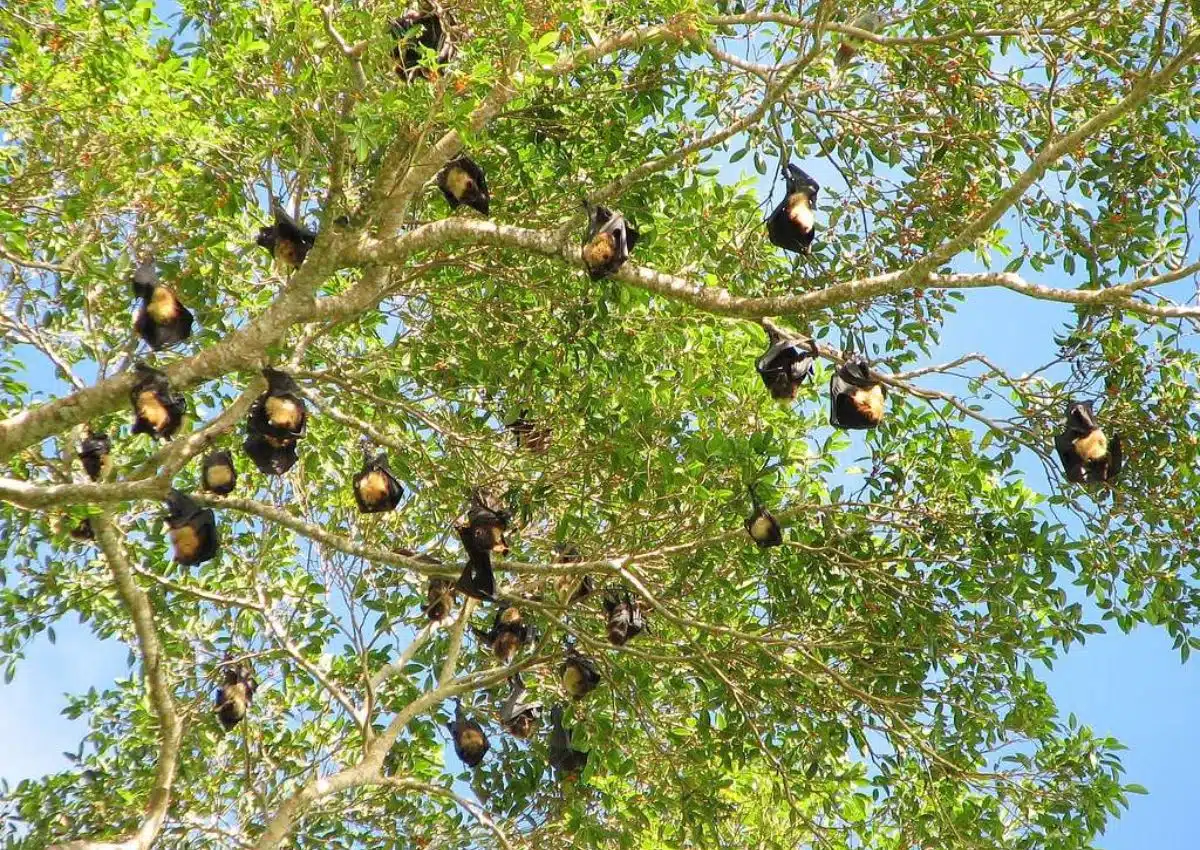
The park aims not only to preserve the natural resources but also to protect the Polynesian culture, showcasing how the Samoan people have lived in harmony with nature for over 3,000 years.
Wildlife: The park is home to the endangered flying fox or fruit bat, vibrant coral reefs teeming with over 900 species of fish, and the rare Samoan whistler bird.
Trails:
- Mount ‘Alava Adventure Trail (7 miles roundtrip): This challenging trek offers panoramic views of the Pago Pago Harbor and encounters with native birds.
- Polauta Island Trail (0.5 miles): A short journey to an overlook, providing stunning vistas of azure waters and the island’s rugged coastline.
- Blunts Point Trail (1 mile roundtrip): Meandering through lush rainforests, this trail showcases World War II gun emplacements and panoramic ocean views.
62. Biscayne National Park, Florida
Primarily underwater, this park preserves the mangrove coastline, the shallow bay, the coral limestone keys, and the offshore Florida Reef.
Wildlife: Manatees glide through its waters, while ospreys and pelicans dominate the skies.
Trails:
- Jetty Trail (0.5 miles roundtrip): Overlook the bay and the Miami skyline.
- Dante Fascell Visitor Center Trail (0.3 miles): A brief path featuring artworks inspired by the park.
- Boat and Snorkeling Tours (Variable distances): The best way to experience the park’s coral reefs and shipwrecks.
63. Virgin Islands National Park, US Virgin Islands
Nestled on the island of St. John, Virgin Islands National Park covers approximately 60% of the island’s land area and encompasses a stunning array of beaches, coral reefs, and tropical forests. It’s a haven for those seeking sun-kissed shores and the vibrant marine life of the Caribbean.
Wildlife: The crystalline waters are home to sea turtles, rays, and a myriad of tropical fish. On land, the park shelters the island’s native fauna, including the St. John deer, various lizard species, and colorful tropical birds like the bananaquit.
Trails:
- Reef Bay Trail (4.2 miles roundtrip): This trail descends through lush forests, past ancient petroglyphs, and ends at the historic Reef Bay Sugar Mill.
- Cinnamon Bay Loop (1.1 miles): Offering panoramic views of Cinnamon Bay and the Caribbean, this trail winds through the remains of historic sugarcane plantations.
- Rams Head Trail (1 mile roundtrip): Starting from Salt Pond Bay, hikers can ascend to Rams Head Point for a 360-degree view of the park’s turquoise waters and surrounding islands.
Which state has the most National parks?
California holds the distinction of being the state with the most national parks within its boundaries. Boasting nine national parks, each with its unique allure and natural beauty, California is a haven for outdoor enthusiasts and nature lovers.
From the iconic granite cliffs and waterfalls of Yosemite National Park to the mesmerizing groves of ancient sequoias in Sequoia and Kings Canyon National Parks, the state offers an array of diverse landscapes. The mystical forests of Redwood National Park, where trees soar to incredible heights, provide a stark contrast to the arid, yet stunning, desert landscapes of Joshua Tree National Park.
The state is also home to the world’s lowest, hottest, and driest national park, Death Valley, as well as Channel Islands National Park, which encompasses five rugged islands and their ocean environment.
Pinnacles National Park, known for its unique rock formations, and Lassen Volcanic National Park, with its geothermal wonders, further showcase the state’s geological diversity. Each park tells a unique story, making California not only the state with the most national parks but also one of the most ecologically diverse regions in the U.S.
What are the 5 largest national parks?
Wrangell-St. Elias National Park & Preserve in Alaska stands as the undisputed titan among the U.S. National Parks, stretching across an astounding 13.2 million acres. This expansive park is a mesmerizing blend of glaciers, mountains, and rivers. It’s a realm where one can truly grasp the raw beauty of nature on a monumental scale.
Not far behind, the Gates of the Arctic National Park & Preserve encapsulates over 8.4 million acres of pristine Alaskan wilderness. Situated entirely within the Arctic Circle, this park is a testament to the untamed landscapes of the far north, where the midnight sun and polar night dominate.
Denali National Park & Preserve is another Alaskan gem, covering over 6 million acres. The park is home to the towering Denali, North America’s highest peak, and serves as a refuge for a plethora of wildlife, from grizzlies to caribou.
The fourth vast expanse is Katmai National Park & Preserve, also in Alaska, spanning over 4 million acres. Renowned for its volcanic landscape and the legendary Brooks Falls, it’s a haven for brown bears and salmon.
Lastly, Death Valley National Park, straddling California and Nevada, covers more than 3.4 million acres. As the hottest, driest, and lowest national park, it offers a unique and extreme desert landscape dotted with colorful rocks, sand dunes, and a rich history.
These parks not only showcase the diverse landscapes of the U.S. but also the vastness that the American wilderness has to offer.
How can we keep track of national parks visited?
One popular method to keep track of national parks visited is by purchasing a “National Parks Passport.” With this booklet, visitors can collect stamps at each national park they visit.
The stamps are free and available at park visitor centers. Another modern method is to use various mobile apps or websites that allow you to log each visit, often with photos and notes. You can also maintain a personal journal or diary of your visits, noting down experiences, wildlife sightings, and hikes.
What is the smallest national park in the US?
Gateway Arch National Park in Missouri is the smallest national park by area, encompassing just 192.83 acres.
Are there 62 or 63 national parks?
As of the last update, there are 63 national parks in the United States.
What national park is in 3 states?
Yellowstone National Park spans three states: Wyoming, Montana, and Idaho.
15 Pro Tips for Visiting US National Parks
For outdoor enthusiasts seeking extraordinary experiences in U.S. National Parks, these 15 expert tips will enhance your wildlife encounters and enrich your journey:
- Wildlife Immersion: Achieve awe-inspiring wildlife encounters with premium binoculars and in-depth knowledge of local species.
- Trail Mastery: Choose high-performance, moisture-wicking apparel and trail shoes designed for rugged terrains for superior hiking comfort.
- Safety Protocol: Prioritize safety by mastering park regulations, carrying essential gear, and sharing your itinerary with a trusted contact.
- Nature’s Keep: Embrace Leave No Trace principles to preserve the pristine beauty of these natural wonders.
- Bloom Bliss: Plan trips around wildflower seasons to witness breathtaking floral spectacles.
- Avian Adventures: Pack a bird guidebook and familiarize yourself with local birdlife through their calls and distinctive features.
- Starry Nights: Unlock the wonders of the night sky by tracking moon phases and attending ranger-led stargazing sessions.
- Off-Peak Serenity: Opt for shoulder seasons to escape the crowds, spot more wildlife, and secure coveted campsite reservations.
- Tracking Expertise: Sharpen your animal tracking skills to identify traces, scat, and signs for thrilling wildlife encounters.
- Weather Resilience: Monitor weather forecasts and come prepared with versatile layers and rain-ready gear.
- Hidden Gems: Seek out lesser-known parks for quieter adventures and unique discoveries.
- Ranger Guidance: Tap into the vast knowledge of park rangers by joining their guided programs for insider insights.
- Respectful Observation: Maintain a safe distance from wildlife, avoid feeding them, and practice unobtrusive observation.
- Nature’s Symphony: Tune in to the natural soundscape, from melodious bird songs to babbling brooks, by honing your listening skills.
- Conservation Involvement: Engage with citizen science initiatives to actively contribute to park preservation.
With these comprehensive strategies, your U.S. National Park explorations will become immersive, educational, and unforgettable.
Final Thoughts: Embrace the Untamed Beauty of U.S. National Parks
In a world where urbanization continues to rise, the U.S. National Parks stand as remarkable sanctuaries of unspoiled wilderness. Each park offers a unique tapestry of landscapes, from soaring mountain ranges to pristine coastlines and otherworldly deserts. These natural wonders not only beckon outdoor enthusiasts and wildlife lovers but also serve as vital havens for countless species of flora and fauna.
Exploring the 63 national parks in the United States is an opportunity to reconnect with the earth, to witness the astounding resilience of nature, and to appreciate the delicate balance of ecosystems that thrive in these protected domains. It’s a chance to embark on adventures that not only refresh the body and mind but also rekindle a sense of wonder.
As you journey through these national treasures, remember that they are not just destinations but legacies—testaments to the enduring commitment of conservationists, rangers, and advocates. Embrace the privilege of treading lightly on these hallowed grounds, respecting the wildlife, ecosystems, and fellow visitors who share in the awe-inspiring experience.
Whether you seek the serenity of ancient forests, the thrill of wildlife encounters, or the challenge of conquering rugged trails, U.S. National Parks invite you to uncover the secrets of the great outdoors. So, pack your gear, heed expert advice, and embark on a transformative adventure that leaves you forever connected to the wild heart of America.

